July 30, 2009
Gergiev's Covent Garden Ring is a primary school travesty, so I walked out
By Damian Thompson [Daily Telegraph, 30 July 2009]
I knew the Mariinsky’s Ring Cycle had shocking reviews when it was staged in Cardiff, but I had no idea it would be this bad. Or that anything could be this bad, really. I walked out after the first hour of Rheingold at Covent Garden last night - and there’s no interval. Fortunately I was at the end of a row in the gods, so it took about 30 seconds to reach the door and breathe a sigh of relief.
Wo gibt's hier Spaghetti?
Von Nicolas Stemann [Süddeutschen Zeitung, 30 July 2009]
Mit seiner Rede zur Eröffnung der Salzburger Festspiele hat der Schriftsteller Daniel Kehlmann die Debatte um das so genannte Regietheater neu entfacht. Kehlmann griff das Gegenwartstheater, in dem sich die Regisseure nicht mehr als “Diener des Autors” verstünden, in einer Pauschalkritik scharf an und machte es dafür verantwortlich, dass sein Vater, der Regisseur Michael Kehlmann, nicht mehr arbeiten konnte, weil er als “altmodisch” galt. Kehlmann sieht im deutschsprachigen Schauspielbetrieb ein gesinnungslinkes “Bündnis zwischen Kitsch und Avantgarde” am Werk. Ob man Schiller in historischen Kostümen oder aktualisiert aufführen solle, sei die “am stärksten mit Ideologie befrachtete Frage überhaupt”. Ausländische Theaterbesucher würden sich nur noch wundern: “Wozu all das Gezucke und routiniert hysterische Geschrei?”
July 29, 2009
Gluck by Bampton Classical Opera
These concert performances of two little-known ‘pre-reform’ works by Gluck — La danza (1755) and Le cinesi (1754) — on the small stage at the Wigmore Hall certainly confirmed the company’s commitment to undeservedly neglected works of the early classical period, and consistently high musical standards served to convince the audience of the merit and beauty of these unfamiliar treasures.
Before he had the good fortune, at almost 50 years-of-age, to become acquainted with the group of ‘reformers’ gathered at the Viennese court — theatre Intendant, Count Durazzo; poet, Raniero de Calzabigi; choreographer, Angiolini; and designer, Quaglio — Gluck was a moderately successful composer of Metastasian opera seria. His reputation today derives largely from his status as ‘reformer’ — as exemplified by his later, innovative, operas, Orfeo ed Euridice, Alceste and the two stories of Iphigénie.
The Preface to Alceste (1767) set forth the new operatic creed. Gluck professed his desire to diminish the pre-eminence of the voice as a virtuoso solo instrument, to create greater continuity of design, and to unite the dramatic action with the emotional expression of the musical score. However, as the esteemed musicologist Winton Dean has remarked, ‘[t]here never was a “reformer” so little in advance of his age and so perfectly adapted to swimming with the current rather than against it’. Gluck certainly had no inherent distaste for the traditional Italian vocal style. For more than twenty-years he had been purveying ‘old-style’ opera seria in the courts of Europe, and indeed he did not abandon the genre after the success of Orfeo (1762), going on to set three more libretti by Metastasio in the 1760s. But, while he may not have been a radical, preferring to ‘lead from behind’, Gluck clearly recognised a good opportunity when he saw one — and it is this practical awareness of musical and dramatic context, coupled with the ability to maximise his own skills, which is equally evident in these two ‘pre-reform’ works. Like his later operas, they are both characterised by a supreme feeling for melody, a sure sense of balance, and by a keen ear for instrumental colour and texture.
La danza is typical of Gluck’s operas in that it presents a mythological situation as a vehicle for making general declarations about human nature. Composed in 1755 for the birthday of the future Emperor Leopold II, it presents a conversation between the delightful nymph, Nice, who is required to dance at a forthcoming festival, and her beloved, the shepherd, Tirsi, who fears that her beauty will undoubtedly attract other suitors and lead inevitably to her infidelity. In a sequence of alternating arias, the lovers — whose romance must, for reasons not disclosed, be kept secret — discourse on love and jealousy, fear and betrayal, honesty and faithfulness, closing with a rather inconclusive duet (repeated, perhaps to lend greater conviction to its sentiments …) in which they both declare, ‘I was born to yearn — for you alone’ (‘Per te sola … io son nato a sospirar’).
Originally described as a componimento drammatico pastorale, this short work is in fact distinctly lacking in dramatic development or momentum; but, nevertheless, the debate between the suspicious shepherd and the self-composed nymph ranges through various emotional and human dilemmas, and the lyricism and sincerity of the vocal lines is enhanced by an array of instrumental colours and textures - the cor anglais, oboes and horns which suggest Tirsi’s anxiety and forthrightness in the opening aria, giving way to gentle string colours, tinted by the bassoon, to complement Nice’s protestation of fidelity and steadfastness. The Bampton Classical Players, performing on period instruments and led from the harpsichord by Christian Curnyn, provided sensitive and alert support throughout; while the instrumental parts lack contrapuntal interest, the context does not in fact require it, and colour and timbre introduce a dramatic element.
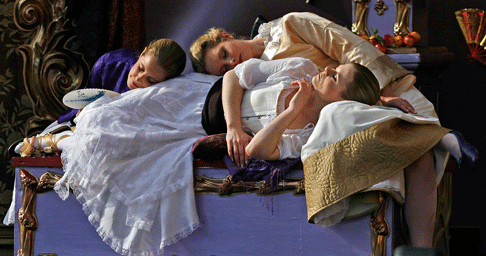 Serena Kay (Tangia); Martene Grimson (Sivene); Lina Markeby (Lisinga) [Photo © Anthony Hall]
Serena Kay (Tangia); Martene Grimson (Sivene); Lina Markeby (Lisinga) [Photo © Anthony Hall]
The two principals, Martene Grimson (Nice) and Nicholas Sharratt (Tirsi), proved themselves equally adept at attaining the ‘beautiful simplicity’ which Gluck declared to be his aspiration. Sharratt’s rich, warm, lower register suitably conveyed the shepherd’s earnestness and concern, and he skilfully applied appropriate nuance to particular textual phrases to add weight and dimension to the sketched character. While her articulation of the Italian text was less precise, Grimson confidently tackled a virtuosic part; at the top of her range her voice has an impressive accuracy, clarity and attack, which she employed to convey the nymph’s insistent assertions of her honesty and dependability, and she nimbly despatched the rapid passage work.
Despite the fact that the work is in essence a simple cantata, it was perhaps a shame that the two soloists preferred to sing directly to the audience, rather than to each other, Grimson remaining quite self-contained even in the final duet. The two music-stands, isolated to the right and left of the conductor, exacerbated the absence of dramatic engagement, which was a pity since the gentle, tender interchanges between the two characters were serenely and affectively sung.
There was more dramatic vitality post-interval in Le Cinesi, composed by Gluck for a festival in 1754. In that year, Empress Maria Theresa had appointed Gluck opera Kapellmeister to the court theatre in Vienna, a post which required him to compose in the livelier, more flexible style of the fashionable French opéras comiques. The composer put his familiarity with various operatic styles and conventions to good use in this opera — a forerunner in the genre of ‘opera about opera’. The scenario is trivial but charming and concise. Three ‘Chinese’ ladies, wile away a tedious evening, confined to the women’s quarters, when they are surprisingly joined by an illicit male interloper from Europe. As romantic attractions begin to surface, they determine to pass the time by play-acting, each of the ladies selecting a different genre — seria, pastorale and buffa. The lone make, Silango, is charged with judging the various merits of the contrasting styles, and their performers. After much melodramatic self-advertisement, flirtatious coquetry and jealous sniping, Silango tactfully suggests that the ladies should abandon their dramatic aspirations and put all their energies into dancing.
First performed in 2008, this production was recently revived at the 2009 Cheltenham festival, and the four soloists slipped quickly and effectively into their roles. Metastasio is not known for his sense of humour — indeed, this is his only ‘comic’ libretto; but the singers made much of the potential for caricature and irony, although some of the anachronisms of Murray Hipkin’s new translation were a little grating. Lina Markeby conveyed the moral self-righteousness and pomposity of the haughty Lisinga to great effect; Tom Raskin was a raffish Silango, suave and confident; while Serena Kay pouted and preened as the feisty Tangia, envious of Silango’s regard for the serene beauty of Sivene (Martene Grimson). The demands, technical and musical, of the long da capo arias, delivered by each principal in turn, are not inconsiderable, but they presented few obstacles to these performers, and Christian Curnyn effectively ensured that dramatic pace and momentum were sustained. Grimson was perhaps feeling the effects of having to perform two demanding roles in one evening for, while she rose to the challenges at the climax of her aria, some of her passage work was a little ragged, with intonation and rhythmic accuracy less than secure. But, overall, the sense of genuine enjoyment and engagement which all the soloists conveyed made one long to see the fully staged production revived once more.
Once again, a performance by Bampton Classical Opera left this listener amazed that such works are not more frequently performed, and convinced that there must be a wealth of unfamiliar repertoire from the late-eighteenth and early-nineteenth centuries that deserves to be resurrected and celebrated — certainly when historical integrity and musical standards are as high as this.
Claire Seymour
image=http://www.operatoday.com/Bampton_MG_7845.gif image_description=Tom Raskin (Silango); Martene Grimson (Sivene) [Photo © Anthony Hall] product=yes product_title=C.W. Gluck: La danza and Le Cinesi product_by=La danza: Martene Grimson (Nice); Nicholas Sharratt (Tirsi).Le cinesi: Martene Grimson (Sivene); Serena Kay (Tangia); Lina Markeby (Lisinga); Tom Raskin (Silango). Bampton Classical Opera. Conductor: Christian Curnyn. product_id=Above: Tom Raskin (Silango); Martene Grimson (Sivene) [Photo © Anthony Hall]
'L'Amico Fritz' stirs emotions
Joshua Kosman [SF Chronicle, 29 July 2009]
The summer activities of the Merola Opera Program provide a perfect opportunity for discovery - and as long as we’re being introduced to gifted young singers, why not some unfamiliar repertoire as well?
Schubert bounces along at Wigmore Hall
The program was promising, an intelligent mix of much-loved Schubert staples with relative rarities which the Wigmore Hall’s specialist audience eagerly anticipated. By its very nature Lieder is more extreme than ordinary song. Good Lieder recitals shouldn’t be tame. But the reckless pace at which Drake was playing seemed to stem from something quite outside the music. His “tempi” were so fast that all sense of phrasing was lost. Drake has the technical facility to play at breakneck speeds without losing notes, but this relentless pressure distorted line and meaning. And Lieder without meaning aren’t Lieder.
Since each song is individual, its character needs to be respected. Drake lurched from one song to the next without a break, sometimes almost before the resonant echoes of the last had faded. Switching from the contemplative “Freiwilliges Versinken” (D 700), with its images of a pale moon and resignation, to the stormy “Der zürnenden Diana” (D 707b) might in some circumstances be dramatic, but when every song and every traverse is treated the same hurried way, the songs tumble into a jumble.
The audience was disregarded, too. Pauses between songs allow listeners to reflect on what they’ve heard, for Lieder is about making listeners think. Now there wasn’t even time to turn a page, or to cough to break tension. Only after the performance ended, did Drake take an extended break, claiming he couldn’t find the score for the encore, laughing as if it were a joke. Since the encore was “Die Forellen” (D 550), and everyone knew there’d be an encore, this seemed contrived.
When Drake wasn’t aiming for an Olympic speed record, his touch was heavy and dominant. “An mein Klavier” (D 342) refers to a fortepiano. The melody lilts, for it’s a “sanftes Klavier”. This clavier, instead, gave extra force to the term “Hammer”-klavier.
To Ian Bostridge’s credit, he managed to match Drake’s pace for the most part. In the last few years, he’s developed much greater control and depth. Indeed, a friend of mine heard this concert a few weeks ago at Schwarzenberg and said that, if anything Bostridge’s voice was in even better form this evening. My friend, who hears 50 or more Lieder recitals a year, hasn’t in the past been a big Bostridge fan, but has become convinced by the singer’s increasing poise and confidence,. Now that’s tinged with respect for the way Bostridge handled the wayward dynamics.
“Der Wanderer” (D 489, von Lübeck) showed how Bostridge can float legato with the fluidity of a clarinet, yet imbue words with great meaning. Lieder aren’t a medium for bland purity: a singer has to care about the words. This is one of Bostridge’s great strengths. He’s clearly thought through less well known songs like “Die Perle” (D 466, Jacobi) where the poet knows he’ll never find the pearl he’s searching for. A pity that the marking “schrietend “(at a walking pace) was so rushed that it pushed the poet to his death before giving him a chance to savor his predicament with true Romantic pathos.
Ballads like “Lied des Gefangenen Jägers” (D 843) and “Normans Gesang,” (D 846) both to texts by Sir Walter Scott, need vivid expression to create interest, which Bostridge’s emphasis on meaning provided. Then, in a burst of impassioned energy, he threw himself into the Mayrhofer song “An die Freude” (D 654), giving it greater portent than I’ve ever heard before. Mayrhofer, a neurotic with whom Schubert later fell out, contemplates death, when friends will bring flowers to his grave. “Rejoice,” sings the poet, “Dies alles ist dem Toten gliech” (“all this means nothing to me now”). Despite the turbulent piano, Bostridge had perspective, and sang with grace.
Wonderful program notes by Richard Stokes. Most program notes are ephemera, geared to the most basic readership. Stokes’s notes combine insight into the music and poems with knowledge of wider cultural background. He gives details even the astute Wigmore Hall audience might miss. For example, “Das Zügenglöcklein” (D 871) isn’t just any bell but one traditionally rung in Austrian villagers when parishioners lay dying, to prepare them for the next world. In our frantic modern times, we don’t reflect on simple, quiet things like that. Stokes makes us realize just how relevant Schubert is to us today.
Anne Ozorio
image=http://www.operatoday.com/bostridge-portrait.gif image_description=Ian Bostridge
product=yes
producttitle=Schubert Songs
productby=Ian Bostridge (tenor), Julius Drake (piano)
July 25th 2009. Wigmore Hall, London
product_id=Above: Ian Bostridge
Busoni: Doktor Faust
Unlike many of his forebears in the nineteenth century, he did not adapt the version of the story by Goethe but, instead, returned to the older tradition of the story as found in the puppet plays. While Busoni otherwise respected Goethe, for the opera Doktor Faust, his decision to pursue the earlier form of the Faust legend disallowed any comparisons between his new opera and the existing ones which take their cue from Goethe. The differences lie in detail, rather than substance, but in Busoni’s hand the ambiguous tone of the dénouement avoids the religious overtones found with Gounod or the eschatological ones with Berlioz’s Damnation de Faust. Rather, the various elements he drew upon offer different perspectives, as with the blurring of the images of the crucifix and Helen of Troy at the ending and similar details earlier in the work. Both the dramatic structure of the opera and the musical idiom Busoni used to present it, separate this modern Faust from the musical settings of the story that emerged in the nineteenth century. Likewise, the conclusion, with its question about what just transpired brings a sense of open-endedness, akin to the approach Alfred Schnittke would take up later in the twentieth century in his own opera on this topic.
The present DVD of the recent Zurich production of Busoni’s Doktor Faust preserves the stage of Kalus Mchael Grüber, whose representation sets and almost choreographed movement to bring the score to his audiences in 2006. In fact, this film is indebted to the televised version which was directed by Felix Breisach, which makes effective use of close-ups and long shots to translate the production from stage to screen effectively. Thus, the image of the homunculus, which is critical in the opera’s opening, does not risk being obscured, as is possible when an opera DVD is simply an opera film from the stage. More important, the close-ups of Hampson as the impassioned and determined Faust are given proper attention, and the various representations of the spirit entities benefit from camera angles that bring them visually into the evocative musical score. Here, too, it is possible to appreciate Hampson’s command of the title role through his speaking, singing, and acting. His interaction with the symbols of the spirits gives the impression of someone experiencing the diabolic phenomena directly.
This emerges from Hampson’s own artistry and is also the result of the fine forces assembled for this production. Hampson becomes his Faust, a character rooted in the alchemy of the late Middle Ages and the early Renaissance. Only then is it possible to understand the context of the lengthy episode at the court of Parma, a duchy which is but one of the rival city-states that cultivated the kind of learning a Faust-like scholar could bring to it. Almost any traditional version of the Faust story requires the appearance of the Lucifer himself or through his devil Mephistopheles. In this opera, the role of Mephistopheles is given to a tenor, and Gregory Kunde gives it an apt reading. Without overacting, Kunde conveys the powerful dynamics of Faust’s bargain. Kunde is also a fine actor and, in this work, he must return his Mephistopheles to the stage, as the character emerges in various guises throughout the rest of Faust’s tragic life - as a monk, a herald, a cleric, a courier and, ultimately the nightwatchman who brings the work to its conclusion.
The other members of the cast include Günther Groissböck as Wagner, Faust’s “famulus” as the libretto has it, and he worked within the dramatic tension between Hampson and Kunde. In the various roles including the Duke of Parma, Reinaldo Macias differentiated each of the parts well. And Sandra Trattnigg deserves attention for her commanding vocal and dramatic presence in the first scene, the one in which Mefistopheles takes Faust to the court of Parma. Along with these soloists, the chorus of the Zurich Opera House was impressive for its clear sound and command of the music. Within the work, though, the dramatic structure revolves around the personas of Faust and Mefistopheles. Thomas Hampson and Gregory Kunde stand out for their powerful interpretations of their characters.
Moreover, the two singers work together well in the first part of the opera, but the second scene stands out for the intensity involved. At this point in the opera, Faust has returned from the court at Parma, and he is in the middle of an animated discussion among the scholars at Wittenberg. The debate is of interest for the various musical motifs in its structure, and this section stands as prelude to the question about Faust’s romantic interest. Here Hampson makes the declamatory lines by Busoni impassioned, and is then interrupted by Mephistopheles who, as messenger, tells of the death of the Duchess of Parma and the subsequent passing of her child, implicitly with Faust.
Kunde makes this scene work through clear delivery, fine diction, and understatement. In response to Faust’s frustration, the empty promise of Mephistopheles to bring Helen of Troy out of the past, contributes a further level of deception, which Hampson embodies well in this performance. Truly in this performance, the sense of despair as a mortal sin comes across profoundly, and this connected with the apt phrasing and pacing by Hampson. Even if this were a concert performance, that sense of emptiness would be aurally present. Yet in this staging, the descent of Faust adds a dimension to the tragedy which may not have been intended in the moralizing puppet-play tradition Busoni developed well.
That conclusion, though, is problematic, since Busoni did not complete his Doktor Faust, but stopped work near its ending. Busoni’s student Philipp Jarnach brought the score to completion for its premiere in 1925, a year after Busoni’s death. However, the British conductor Antony Beaumont found sketches for additional music, and Beaumont brought them into his 1985 completion of the Busoni’s opera. The present performance is based on Jarnach’s score, which is, perhaps, the more familiar of the two. By integrating movement into the staging, Grüber created a memorable production of a work which Hampson himself suggests in the interview (found on the second disc) as unsingable. The staging plays well with the depth of the stage, to give a sense of space into which the audience can enter. This space is the setting for some fine visual effects, particularly the use of pure colors to underscore the scenes. The special effects are minimal, leaving the enchantments implicit in the text to occur in the imaginations of the audience and the viewers of the film. Instead, the powerful images that remain in memory are those of Hampson as he puts a human face and moving voice to Faust. Likewise, the orchestra is notable for its clean, precise playing under the precise direction of Philippe Jordan. The orchestral interludes, like the ones Berg used in the operas he composed around the same time, merit attention on their own, and Jordan makes them work well within the larger structures of the scenes with which they are associated. The sound on the recording is also clear and allows the orchestra to emerge distinctly on this DVD.
This is a version of the Faust story which merits attention, and its recent release on DVD makes the opera accessible to a wider audience than the one for this production or even the television broadcast. Busoni’s Doktor Faust is a solid work which succeeds through the masterful performance found in this recording.
The DVD includes a booklet, which has the scenes keyed to a synopsis of action, rather than a complete libretto. Yet the text may be apprehended in German, French, English or Spanish, and those subtitles may be turned off readily. The interviews found on the second CD offer insights into the work from viewpoints of Thomas Hampson and Philippe Jordan, and the inclusion of the material is a wise choice by Arthaus in this fine DVD of Busoni’s Doktor Faust.
James L. Zychowicz
image=http://www.operatoday.com/Arthaus101283.gif imagedescription=Ferruccio Busoni: Doktor Faust
product=yes
producttitle=Ferruccio Busoni: Doktor Faust
productby=Doktor Faust: Thomas Hampson; Wagner, sein Famulus / Zeremonienmeister: Günther Groissböck; Mephistopheles: Gregory Kunde: Der Herzog von Parma / Des Mädchens Bruder / Soldat: Reinaldo Macias; Die Herzogin von Parma: Sandra Trattnigg; Ein Leutnant: Martin Zysset. Chorus and Orchestra of the Zurich Opera House (chorus master: Jürg Hämmerli). Philippe Jordan, conductor. Klaus Michael Grüber, stage director. Eduardo Arroyo, stage design. Eva Dessecker, costumes. Jürgen Hoffmann, lighting.
Recorded live from the Zurich Opera House, 2006
product_id=Arthaus 101283 [2DVDs]
July 28, 2009
Kát’a Kabanová at Holland Park
Geoff Brown [Times Online, 28 July 2009]
Anne Sophie Duprels’s opera heroine must be one of the few to think of committing suicide by throwing herself into the orchestra’s timpanist. It should be the River Volga, but Opera Holland Park’s production of Janácek’s searing marvel Kát’a Kabanová — their last attraction in this summer’s season — never comes near water. At the same outdoor venue in 2007, the director Olivia Fuchs, the designer Yannis Thavoris and their team scored a palpable hit with Jenufa, but here, despite firm performances, the Czech composer’s power gets neutered by a staging that swings madly between the over-emphatic and the thrown-away.
July 27, 2009
An Evening at Père Lachaise [Or, Natalie Dessay Attempts Violetta]
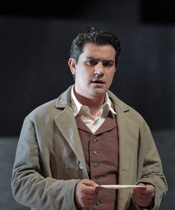 Saimir Pirgu (Alfredo)
Saimir Pirgu (Alfredo)
During the intensely dramatic prelude to Act IV, anonymous stage figures in
half light, darted about draping the tombs with white shrouds preparing the
death scene of Violetta — so much for that essential orchestral moment;
again our attention had fled. For Flora Bervoix’s Act III party, the
weighty boxes, artfully arranged at varying heights, served as pedestals to
show off swaying party girls in lavish 20th century dancing gowns.
“Dancing on her grave?” Santa Fe’s new mounting of
Verdi’s opera, largely the work of a director Laurent Pelly’s
French team and the prima donna Natalie Dessay, seemed an evening at Père
Lachaise, almost literally, but Lachaise-manqué, transmogrified. The conceit
was interesting; many in the audience liked it and enjoyed its innovative
energy, yet it was, as we say, for its own sake — it added no new insight
into the old opera. It could also get in the way.
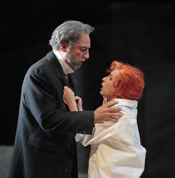 Laurent Naouri (Germont) & Natalie Dessay (Violetta)
Laurent Naouri (Germont) & Natalie Dessay (Violetta)
Opinion divides on Mme. Dessay, as it usually will when coloraturas essay
Violetta’s essentially dramatic role. Through history, light-voiced divas
such as Galli-Curci, Lily Pons and Roberta Peters have tried and faded with the
fatal part. Deconstructively ruinous at Santa Fe was Dessay’s Act II
costume — dull, shapeless cotton slacks and a large man’s-style
white overshirt; barefoot. She was a 1960s hippie caught at home. The problem
was it robbed her of much dignity: and Violetta’s self-denying dignity is
key to the effect of this central act, with the two Germont men, each asking
her something different, and opposing. She is cruelly torn; it takes all her
resources to survive intact. By dressing her way down for the big confrontation
scenes, Dessay’s Violetta lost a lot of feminine stature and,
unintentionally I am sure, pushed her comic-seeming side; she looked raffish
and moved in an almost Carol Burnett way — all wrong. Producer Pelly got
this act badly off key. To do anything to defeminize Violetta is a grave
mistake. Violetta must be poignantly believable in Act II — or her show
does not fly, hélas!
The device of the graveyard underlying the whole opera seemed an over-kill, ultimately a kind of director’s bad joke. Once again, where was dignity, seriousness? La traviata is a mid-19th century tragic opera, with many social overtones; it is most certainly to be taken seriously. But I did not sense a lot of that with M. Pelly, though the performing artists worked hard. Where was letting the music speak for itself (as in the two preludes mentioned above)? Is it anything less than an affront to second-guess Giuseppe Verdi in judging the effect of his music, and what it takes to put it over in theatrical terms? Opera lovers will have their own views on this. In an interesting touch, Père Germont was costumed and played as a 19th century figure, and that he surely is; but Violetta is no less so, and to take her out of that cultural milieu was counterproductive.
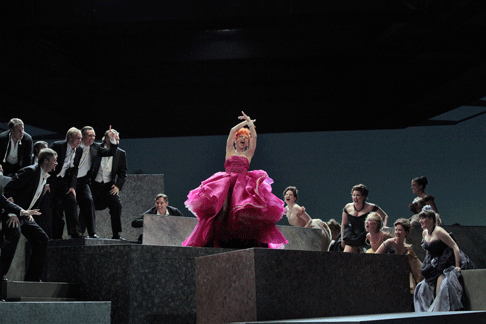 Natalie Dessay (Violetta)
Natalie Dessay (Violetta)
Finally, Mme. Dessay is not a Violetta. As seen on the Santa Fe stage, she is a little bird — in Act I a frantic, drunken little bird with an orange wig and bright red and pink plumage; by the end she was a plucked pullet flopping about the stage. Her voice does not have the dynamic or tonal range to explore the full dimensions of Verdi’s music or Violetta’s emotions; it is almost always the same color. She was wise to sing both stanzas of “Addio del passato…” for a soft pianissimo tone is her best asset just now, and she long held the aria’s final p. high-A. A singular moment. I like Mme. Dessay a lot, and she’s had a wonderful career, especially considering two throat surgeries and a baritone husband. I think she has the spunk, but ultimately not enough vocal resource to do justice to Verdi’s paragon soprano role. The surprise of the evening was the excellence of Parisian baritone Laurent Naouri in the role of Père Germont. His well-voiced traditional portrayal played strongly against the eccentricity of the rest of the production; he showed vividly how this wonderful opera should be treated. The young Alfredo was debut artist Saimir Pirgu, an Albanian tenor with a pleasing voice and manner, graced by a nice smile. In the latter stages of the opera he warmed to some beautiful soft-toned singing.
J. A. Van Sant ©2009
image=http://www.operatoday.com/_MG_4060a.gif image_description=Natalie Dessay as Violetta [Photo by Ken Howard courtesy of Santa Fe Opera] product=yes product_title=Giuseppe Verdi: La traviata product_by=Violetta: Natalie Dessay; Alfredo: Saimir Pirgu; Gastone: Keith Jameson; Germont: (through Aug. 17) Laurent Naouri, (Aug. 22, 26, 29), Anthony Michaels-Moore; Douphol: Wayne Tigges; Dr. Grenvil: Harold Wilson. Conductor: Frederic Chaslin. Director: Laurent Pelly. Scenic Designer: Chantal Thomas. Costume Designer: Laurent Pelly. Lighting Designer: Duane Schuler. product_id=Above: Natalie Dessay as ViolettaAll photos by Ken Howard courtesy of Santa Fe Opera
July 26, 2009
GOUNOD: Faust — Vienna 2008
Music composed by Charles Gounod. Libretto by Jules Barbier and Michel Carré after Faust by Johann Wolfgang von Goethe
First performance: 19 March 1859 at Théatre-Lyrique, Paris
| Principal characters: | |
| Marguerite | Soprano |
| Faust | Tenor |
| Méphistophélès | Bass |
| Valentin | Baritone |
| Wagner | Baritone |
| Siébel | Soprano |
| Marthe | Soprano |
Synopsis:
Act I
Faust’s cabinet.
The philosopher Faust is profoundly depressed by his inaptitude to reach fulfillment through knowledge and thinks of committing suicide. He pours the contents of a poison phial in a cup, but stops suddenly drinking the deadly liquid when he hears a pastoral choir. He damns happiness, science and faith and calls on Satan to guide him. Méphistophélès appears (duet: “Me voici”). Faust confesses to him that he looks for youth, more than wealth, glory and power. Méphistophélès agrees to fulfill the wishes of the philosopher, in exchange for his services in the infernal regions. As Faust hesitates to accept this condition, Méphistophélès has Marguerite appear to him sitting at her spinning wheel. Faust signs then the document and is transformed into a noble young person.
Act II
The carnival at the city gates. One sees a cabaret on the left.
The curtain rises on a joyful choir of students, soldiers, bourgeois, girls and stout women (choir: “Vin ou Bière”). Valentin enters, holdin in his hand a medal which his sister Marguerite gave to him; he is about to leave for war, and is giving instructions to his friends, notably to Wagner and Siébel, so that they take care of her. They sit down to take a last glass.
Méphistophélès appears suddenly, and amuses them with a song on the golden veal (round dance: “Le veau d’or”). Valentin gets angry when Méphistophélès talks lightly about his sister, but his sword breaks in the air before reaching its target. Confronted with a supernatural power, Valentin and his companions brandish crossshaped knobs of their swords in front of the devil (choir: “De l’enfer”). Méphistophélès remains alone, soon joined by Faust and by a group of village waltzers (waltz and choir: “Ainsi que la brise légère”). When Marguerite appears among them, Faust offers her his arm; she refuses with modesty and goes away deftly.
Act III
Marguerite’s garden.
Siébel is in love with Marguerite and sets down a bouquet for her (stanzae: “Faites-lui mes aveux”). Faust and Méphistophélès enter the garden; while the devil is in charge of finding a present for Marguerite, Faust shouts out to Marguerite’s house and to the defending embrace of nature (cavatina: “Salut, demeure chaste et pure”). Méphistophélès returns and sets down a casket with jewels for the girl.
Marguerite arrives, wondering who was the young gentleman who approached her earlier. She sings a ballad on the king of Thulé, discovers the bouquet and the casket of jewels and, quite incited, tries earrings and necklace (scene and air: “Il était un roi de Thulé”). Marthe, Marguerite’s governess, tells her that these jewels have to be the present of an admirer. Méphistophélès and Faust join the two women; the first tries to seduce Marthe, while Faust converses with Marguerite, who shows herself still very reserved (quartet: “Prenez mon bras”).
While Faust and Marguerite disappear for a moment, Méphistophélès casts a fate to the flowers of the garden. Marguerite and Faust return and she allows Faust to kiss her (duet: “Laisse-moi, laisse-moi, contempler ton visage"); however, she steps back suddenly and asks him to go away.
Convinced of the insignificance of his efforts, Faust is resolved to abandon his project altogether. He is stopped by Méphistophélès, who orders him to listen to Marguerite at her window. When hearing that she hopes for his quick return, Faust shows himself and takes her hand; as she drops her head on Faust’s shoulder, Méphistophélès cannot refrain from laughing.
Act IV
Marguerite’s room.
Marguerite has given birth to Faust’s child and is ostracised by girls in the street. Saddened because Faust abandoned her, she sits down at her spinning wheel (air: “Il ne revient pas”). Siébel, always faithful, try to encourage her.
A square.
The return of Valentin is announced with soldiers’ walking, and it becomes clear that things are going to deteriorate. Having heard Siébel’s evasive answers to the questions he asked about his sister, Valentin rushes furiously in the house. While he is inside, Méphistophélès satirically plays the role of lover, giving a serenade under Marguerite’s window (serenade: “Vous qui êtes l’endormie”). Valentin reappears and demands who took his sister’s innocence. Faust pulls his sword; during the ensuing duel, Valentin is lethally wounded. As he dies, he throws back all responsibility on Marguerite and damns her for the eternity.
A cathedral.
Marguerite tries to pray, but is prevented from it by,first, the voice of Méphistophélès, then by a devils’ choir. She finally succeeds in finishing her prayer, but faints when Méphistophélès releases a last curse.
Act V
The mountains of the Harz. The night of Walpurgis.
One hears a choir of will o’ the wisps when Méphistophélès and Faust appear. They are quickly surrounded by witches (choir:”Un, deux et trois”). Faust tries to run away, but Méphistophélès hurries to take him somewhere else. A decorated, populated cave of queens and courtesans of the Antiquity. In the middle of luxurious banquet, Faust sees Marguerite’s image and demands for her. While Méphistophélès and Faust leave, the mountain closes and the witches return.
The inside of a prison.
Marguerite is imprisoned for killing her child, but, thanks to Méphistophélès’s help, Faust obtains the keys of her cell. Marguerite wakes to the sound of Faust’s voice; they sing a duet of love (duet: “Oui, c’est toi que j’aime”) and Faust asks her to run away with him. Méphistophélès appears and begs Faust and Marguerite to follow him. Marguerite resists and calls for divine protection. Desperate, Faust watches and falls to his knees in prayer, while Marguerite’s soul rises towards heaven (highlight: “Christ est ressuscité”).
[Synopsis source: Charles Gounod — His life, his works.]
Click here for the complete libretto.
image=http://www.operatoday.com/Faust_Huet.gif image_description=Faust et Méphistophélès by Paul Huet (1803-1869) audio=yes first_audio_name=Charles Gounod: Faust first_audio_link=http://www.operatoday.com/Faust3.m3u product=yes product_title=Charles Gounod: Faust product_by=Faust: Roberto Alagna; Marguerite: Angela Gheorghiu; Méphistophélès: Kwangchul Youn; Valentin: Adrian Eröd; Siebel: Michaela Selinger; Marthe: Janina Baechle; Wagner: Alexandru Moisiuc. Chor und Orchester der Wiener Staatsoper. Bertrand de Billy, conducting. Wiener Staatsoper, 12 October 2008.July 25, 2009
Jedermanns Theater
[Süddeutschen Zeitung, 25 July 2009]
Mit einer harschen Kritik am Regietheater sind an diesem Samstag die 89. Salzburger Festspiele in Österreich eröffnet worden. Der 34-jährige Schriftsteller Daniel Kehlmann (“Die Vermessung der Welt”) setzte sich in einer sehr persönlichen Festrede mit seinem Vater, dem Regisseur Michael Kehlmann, auseinander und kritisierte scharf den Modernisierungszwang des heutigen Theaters.
July 23, 2009
Munich opera director says public taste is always behind the times
Jens F. Laurson [Deutsche Welle, 23 July 2009]
From his corner office at the top floor of the new administrative building behind the Munich Opera, Nikolaus Bachler, the artistic and managing director of the Bavarian State Opera, overlooks the Royal Stables Plaza. Once an urban dead spot, the square is slowly transforming into a lively node between the English Garden, the Max Planck Institute, and the backside of the Opera house.
July 22, 2009
Bought and Paid-for Magic — Bernstein Tahiti in Munich’s Cuvilliès Theater
Mozart premiered his Idomeneo in the over-the-top rococco jewel-box Cuvilliès Theater, which is named after its designer, the French dwarf / Bavarian court jester / architect. Leonard Bernstein’s 1952 pocket-sized opera Trouble in Tahiti about a loveless American couple in nameless Suburbia would seem far removed from the world which gave rise to this extravagant pocket-sized opera house. And yet — it somehow made tremendous sense to present there. The “bought and paid-for magic” of transparently ridiculous Hollywood daydreams Bernstein wrote about seems oddly at home with Bavarian rococo. If only that the production concept had been less confused!
Bernstein dedicated his seven-scene Trouble in Tahiti to his friend Marc Blitzstein, whose succès de scandale, Cradle Will Rock, Bernstein had set out to “out-cradle” in his first attempt at composing “the great American opera.” The composer wrote the libretto himself. Bernstein may have downplayed emulating Blitzstein’s Marxist principles, but certainly followed him in attempting to forge a music in vernacular popular musical styles of the day rather than more classical operatic style.
In an interview in his office the morning of the third and last performance of the Bernstein on July 10th, Bavarian State Opera Music Director Kent Nagano joked the new Tahiti production, coming a mere two days after the new Wagner opera production he’d conducted at the National Theater, was actually Lohengrin, part 2.
Both operas feature a neglected and non-singing child, although Tahiti’s semi-unnamed “Junior” is simply ignored as both parents miss his debut in the school play. (This is the autobiographical kernel of Bernstein’s work, his never-forgotten bitterness at his own parents for not showing up for his debut as soloist in Grieg’s Piano Concerto with his Boston Latin School Orchestra. The two characters even originally were given the same names as his parents, but at least changed the wife’s name from Jennie to Dinah. Sam remained Sam.) The neglected child in the Wagner, is of course a bit more ponderous, in that the silent Gottfried (not murdered by his sister at all, but hidden in plain sight as a swan!) is hailed as the Führer of the future.
I couldn’t help wondering, however, if it might not have been better to switch the concepts of these two very different productions: The new production of Lohengrin posited the main character as a “visionary” architect. If Trouble in Tahiti really had to have added stage action, an architect creating multiple soulless tract houses in suburbia would have made a great deal of sense! And imagine if Lohengrin had been set in the abandoned amusement park which showed up (to little purpose) in Tahiti the swan would have made perfect sense! Or the silent, walking (or deflated) blow-up doll versions of several of the characters (too even less purpose) which appeared in the Bernstein, had been employed in the Wagner. It would have been so much fun to have blow-up versions of Ortrud and Telaramond deflate.. And might perhaps the giant lizard in Tahiti make more sense as a wannabe swan?
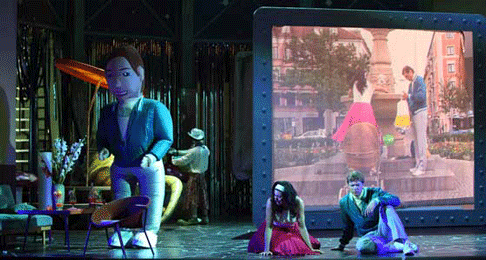 A scene from Trouble in Tahiti
A scene from Trouble in Tahiti
For Tahiti, which is about the spiritual emptiness that acquisition of things imposes, it seems wrong-headed in the extreme to have a production which uses just about every effect and resource conceivable, however distracting, for minimal, momentary effect. On the tiny stage, the singers seemed to be dealing with a traffic jam, aside from the characters and superfluous extras there were blow-up dolls of the characters, even an turntable roundelay set. A giant lizard. A giant polka-dot toadstool. The director left no trick untried. At one point, even the chandeliers over the audience’s heads were made to dance up and down and flash on and off in time to the music for reasons which escaped me. So much business, the music often got lost. In attempting to depict the spiritual hollowness that comes a life lived from possessions alone, this production becomes the problem it wishes to describe.
Bernstein’s original stage requirements actually insist on something quite different: “Simplicity of execution should be the keynote throughout. Much depends upon precise and imaginative lighting... The composer has conceived as cartoon-like sketches — bold, suggestive, and charming. They should be black and white, almost like a child’s version of each scene... The merest suggestion of skyscrapers, a traffic light, etc., will suffice.... The TRIO should wear evening clothes....[Only black and white should be used.] The only note of color in the visual production is furnished by the clothes of the couple...”
This production violated virtually every one of these express wishes of the composer, to little effect. Moreover, Bernstein did not need or expect the son to appear onstage.
Sometimes less is more. As an attack on consumerism, Bernstein tried something quite remarkable and paradoxical in this work: despite the deliberately pop-ish music, it adheres to the classical unities — the action takes place on a single day, explicitly identifying the spiritual ideas with the morning, afternoon, evening, there are only two singing characters, plus a three-voice trio (“a Greek Chorus born of radio commercials” in the description of the composer). The plan harks back to the Camerata which gave birth to opera in the first place, as does Bernstein’s choice of American vernacular as the musical style of choice.
Endearing oddnesses fill this score: The awkward duet where the husband and wife encounter each other by accident on the street and lie to each other about what they’re doing is marked in the score “Tempo di ‘Gymnopédie’“ — an interesting tip of the hat to Eric Satie. In fact, there are many references to other composers in this work. The ending, for example, is a blatant overreach towards the final scene of Wozzeck although the tragedy of this opera and the hurt to the child in question hardly rise to the level of the Berg opera. Tahiti does not lack for critics. Its final scene here strives for a grandiosity of which he was not yet capable, at least not until the La Bohème-like finale of West Side Story. But for me, it’s largely only in the grand opera part of the quotient that he failed here. Outside of that, what he did achieve is vivid and substantial indeed. “Trouble in Tahiti” is a masterpiece of its kind, and it remains fascinating to hear the bursting potential of this 1952 time-capsule from the start of the composer’s career.
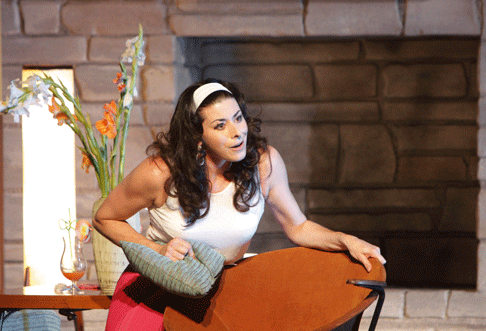 Beth Clayton (Dinah)
Beth Clayton (Dinah)
Tahiti was the eleventh new production to be conducted by Kent Nagano since his appointment as Music Director. These performances marked the world premiere of the new reduced-orchestration (for 14 musicians, instead of Bernstein’s original 21) by Garth Edwin Sunderland. Nagano is utterly at home conducting this music, fluid and convincing, (as he was also with the Lohengrin two days later). Rather than the Bavarian State Opera Orchestra, however, for this production the players of the Mahler Chamber Orchestra were in the pit, and they responded spectacularly well and with a quite stunningly precise purity of intonation. Sunderland’s new arrangement did not seem to have made much compromise of the music, with perhaps only the introduction to Sam’s aria excepted.
The chorus (Angela Brower, Jeffrey Behrens, Todd Boyce) — clown make-up aside — sang wonderfully, beautifully blending their voices to a clear cohesive unit and precise diction, moreover perfectly conveying the musicality of the morning, midday, afternoon and twilight progression of their numbers. The soloists however, were less impressive, although one wonders what they might have done if they’d been allowed to concentrate on singing and not have to cope with all the unnecessary distractions on the stage. Beth Clayton was a good but not tremendously dynamic Dinah. Interestingly, she did not use the “in South Pacific accent” Bernstein stipulated in his score to describe how she is to imitate the “natives’“ singing in her eponymous show-stopper about the imaginary Hollywood South Seas escapist film she’s just seen. (Yes it is racist, and Bernstein, an expert on racism in the arts — that was the topic of his senior Harvard thesis — deliberately intended the shock and humor of that effect, not watered down as it was here.) Rodney Gilfrey had fine diction but trouble being heard as well as a distressingly wide vibrato in held notes in the role of Sam. His physical tightness — was it the small stage? or the odd changes of meter of his music? bad back? — made Sam seem less than the “winner” he is supposed to embody.
The biggest flaw of this Tahiti, however, was the stillborn curtain-raiser director Schorsch Kamerun inserted to introduce the Bernstein. Called “Bevor der Ärger richtig losgeht...” (Before the Trouble Gets Going...), This consisted of four German punk songs with music by David R. Coleman to texts by four different German punk bands: “Diese Menscehn sind ehrlich” (These people are honest) by Die Goldenen Zitronen (The Golden Lemons, the band Mr. Kamerun had sung with in the 1970’s), F.S.K.’s “Das is der morderne Welt” (This is the modern world), as well as “Angst macht keinen Lärm” (Fear makes no noise) by Angeschissen (Shit-upon), and “Es regnet Kaviar” (It’s raining caviar) by Tolerantes Brandenburg (Tolerant Brandenburg). While Bernstein’s 40-minute opera does require something else to make a full evening, this cringe-inducing material was not it. These four punk songs were accompanied by silent video by Jo Schramm of a clown opening a book which displayed a film of imagined disputes between the opera characters (as themselves or as blow-up dolls) in the 1960’s style suburban living room set of the first scene. The clown, not able to do much other look malevolent, eventually just sank his teeth into the book. The set itself was only revealed after the curtain was raised. Over the fireplace was a big painting of a smiley face, and the first action of Dinah was to rotate its mouth from frown to smile.
At the end of his career, Bernstein folded this earlier work into a full-scale opera named after one of Dinah’s songs here, “A Quiet Place.” In the late work, thirty years have gone by, Dinah has died (off-stage) in a car crash, and the family gathers for her funeral. Junior is gay and possibly psychotic and has a sister, Dede, who has married his former lover François. Sam is alienated from everyone. All seek reconciliation. The work has yet to succeed in performance. “I worked with Bernstein when he did A Quiet Place’ in Vienna, Nagano confided with a sigh. “It’s a score that remains on my piano. It’s a visionary work, and like all visionary works, it may someday be better understood.”
A word of praise on a separate note: For those of us who feel that opera is a significant artistic endeavor, one of the great joys of all productions of the Bavarian State Opera is each production is accompanied by an astonishingly hefty, well-produced book filled with not just the libretto text, but also thought-provoking background essays on the work and the production also with additional diverse historical texts which are quite substantial and enlightening (that is, if one reads German). The book for Trouble in Tahiti, for example, is at pains to place this work in its proper context musical, social, political and historic context. This is particularly important to understand for this work, as polymath and polyglot Bernstein intended this work to be an explicitly American opera, eschewing European conventions while favoring — to the extent possible — nativist vernacular. He aimed to elide the full range of compositional alternatives to create an unbroken continuum from popular music to grand opera. To my surprise, the German translation of Bernstein’s quite vernacular 1952 libretto, included in this book, seems to work very well.
Raphael Mostel © 2009
image=http://www.operatoday.com/Tahiti_Munich_01.gif image_description=Rodney Gilfry (Sam), Beth Clayton (Dinah) and Moritz Becker (Sohn) [Photo by Wilfried Hösl courtesy of Bavarian State Opera] product=yes product_title=Leonard Bernstein: Trouble in Tahiti product_by=Dinah: Beth Clayton; Sam: Rodney Gilfry; Jazztrio: Angela Brower, Jeffrey Behrens and Todd Boyce. Mahler Chamber Orchestra. Conductor: Kent Nagano. Production Schorsch Kamerun. Set: Constanze Kümmel. Costumes: Tabea Braun. Lighting Michael Bauer. Video: Jo Schramm. Choreography: Volker Michl. Dramaturgy Andrea Schönhofer. product_id=Above: Rodney Gilfry (Sam), Beth Clayton (Dinah) and Moritz Becker (Sohn)All photos by Wilfried Hösl courtesy of Bavarian State Opera
Mozart: Die Entführung aus dem Serail
Modern dress, department store-window set design, causally explicit sex and/or violence - these are the equivalents to an old-fashioned staging’s overly plush costumes, painted backdrops and formulaic stage posturing. In that regard, this Nederlands Opera Die Entführung aus dem Serail, filmed live in February 2008, is a traditionally non-traditional version of Mozart’s early masterpiece. Working with costume designer Nina von Mechow and set designer Bert Neumann, director Johan Simons strives so hard for freshness and boldness that the viewer is exhausted by the effort expended rather than charmed and moved by the opera itself.
The sets provide no sense of the Pasha Selim’s residence as a place of confinement. A curtain of gold spangles glitters behind a platform, with huge blow-ups of harem-related paintings to either side. Modern furniture matches the modern dress of every character except Kurt Rydl’s Osmin, who gets to look comfortable in loose fabrics, vaguely Turkish. A bonus feature supplies the insight that the set is designed to resemble some sort of theater (in the very opening, two auditorium seats in red fabric are all we see before the curtain). What deeper insight into the opera this “all the world’s a stage” angle supplies evaded your reviewer.
Although director Johan Simons, in the bonus interviews, says all the right things about allegiance to the text and Mozart’s music, what he actually puts on stage seems more about using text and music as a starting point for displaying his own inventiveness. The action becomes frantic and pretentious, unfortunately, instead of mirthful or affecting.
The fatal weakness of the production is a Pasha Selim without a dangerous sex appeal. Steven Van Watermeulen follows the director’s dictates, apparently, and the resulting goofiness saps the drama and emotion from the character’s change of heart at the finale.
Goua Robert Grovugui, a handsome black youth in jeans and t-shirt, plays a mute role, following Selim’s orders, and giving the director the opportunity to have something to do during Belmonte and Constanze’s final duet. As they sing, the youth circles them, clasps the singer’s hands together, listens to their heartbeats, places Aiken’s hand on his head…What is the young man looking for? How do his actions reflect on Belmonte and Constanza’s situation (they expect to be executed soon)? All these questions draw attention to the young man, and by extension to the director as well - as attention is drawn away from the characters.
Fortunately, the musical side of things is more impressive. Laura Aikin’s Constanze, while looking somewhat mature, maintains her dignity. The music pushes her up into her top range, which is secure though sharp-edged. Edgaras Montvidas as Belmonte is youthful, attractive, and his pleasant voice meets the role’s demands well. He just needs a bit more personality to make a greater impression. Mojca Erdmann embodies the sexy, sassy Blonde very well, giving Michael Smallwood’s carefree Pedrillo an energetic counterpart. Kurt Rydl, as expected, steals the show as Osmin, both with his well-preserved bass voice and his comic skills.
Conductor Constantinos Carydis and the Netherlands Chamber Orchestra support the singers with rhythmic precision and plenty of color.
Opus Arte spreads the opera onto two discs (with a break midway through act two), filling the second disc with interviews mixed with rehearsal footage. If not fascinating, at least these short clips don’t mirror the pedantic approach of Klaus Bertish’s academic windiness in the booklet essay.
Your reviewer would still go back to the decades old production with Karl Bohm conducting Francisco Araiza and Edita Gruberova. The classy yet simple production lets the music-making, of a very high level, tell the story. Director Simons doesn’t betray the opera; he simply doesn’t seem to trust it. A lot of effort for too little effect makes this a DVD difficult to recommend.
Chris Mullins
image=http://www.operatoday.com/OA1003D.gif image_description=W. A. Mozart: Die Entführung aus dem Serail
product=yes producttitle=W. A. Mozart: Die Entführung aus dem Serail productby=Konstanze: Laura Aikin; Belmonte: Edgaras Montvidas; Osmin: Kurt Rydl; Blonde: Mojca Erdmann;Pedrillo: Michael Smallwood; Bassa Selim: Steven Van Watermeulen. Chorus of De Nederlandse Opera. The Netherlands Chamber Orchestra. Constantinos Carydis, conductor. Johan Simons, stage director. productid=Opus Arte OA1003D [2DVDs] price=$34.98 producturl=http://www.arkivmusic.com/classical/album.jsp?album_id=211512
July 21, 2009
A knock-out Ariadne auf Naxos at Munich’s Bavarian State Opera Festival
The lucky audience at the Bavarian State Opera Festival’s Ariadne auf Naxos was witness to one of the most remarkably fluid and fun performances of this Richard Strauss work it has been my pleasure to see. The quirky production, every member of the cast — even deeply into the smallest roles — the conductor and the orchestra, all were of a single mind, and all at the top of their game. The result was total, unalloyed delight. It doesn’t get better than this.
From the very beginning, with dozens of mirrors wheeled on to the empty black stage, their reflections and changing placement instantly fracturing the stage focus into kaleidoscopically reconfigured crystalline structures — not unlike in the celebrated climax of Orson Welles’ classic film “Lady from Shanghai,” a chase set in a fun-house of mirrors — this genius production by Robert Carsen beautifully embodied the Hoffmanstahl/Strauss conceit of irrationally mixing up two disparate genres. If perhaps there was one too many upright pianos wheeled onstage here, or an occasional longeur there, these were minor cavils when the whole is such a beautifully realized directorial high-wire act. If theater is just smoke and mirrors, Carsen managed it brilliantly with barely more than the latter.
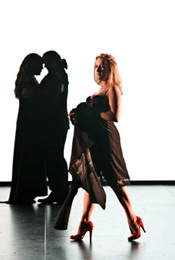 Scene from Ariadne auf Naxos with Diana Damrau as Zerbinetta in the foreground
Scene from Ariadne auf Naxos with Diana Damrau as Zerbinetta in the foreground
The audience’s darling, as it should be, was the Zerbinetta of Diana
Damrau, who proved capable of an astonishing range of physical acting, vocal
pyrotechnics, and plain delight throughout the performance. Her red high heels
came on and off with aplomb as she negotiated the virtuoso demands of the part
and the production. She presents herself with a freshness and seemingly
off-the-cuff decisions that are nothing short of daringly breathtaking. Even
the most strenuous episodes came off with an irrepressible naturalness which is
the opposite of studied. One hardly knows what to praise more, her musicianship
or her acting — but the two cannot be separated. They form a seamless
wonder, with or without those red high-heels.
But Damrau was hardly alone in this deep cast of talented artists. Each contributed his or her more than considerable best. Primadonna/Ariadne, Adrianne Pieczonka and Composer Daniela Sindram were also as magnificent in their fiery roles, and gave no grounds for anything other than complete admiration. Everyone in the cast made the most of their moments to shine. Martin Gantner (Musiklehrer) was suitably aggrieved. Burkhard Fritz was an outstanding Tenor/Bacchus. Nikolay Brochev (Harlequin), Ulrich Ress (Scaramuccio), Steven Humes (Truffaldin), Kevin Conners (Brighella), Christian Rieger (Lakai), Guy de Mey (Tanzmeister), Kenneth Robertson (Offizier), Aga Mikolaj (Najade), Nicole Piccolomini (Dryade), Sine Bundgaard (Echo) were all excellent. Todd Boyce, who two nights before had been one of the clown-chorus of Bernstein’s Trouble in Tahiti, here was an amusing Wigmaker. Non-singing actor Johannes Klama was a most officious Haushofmeister. Bravi tutti.
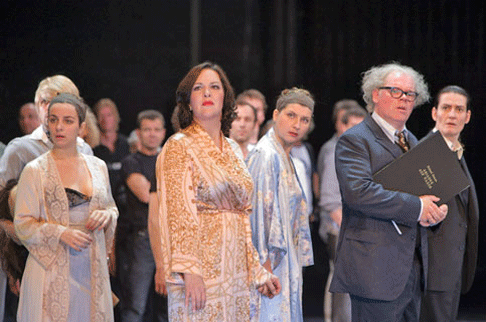 Scene from Ariadne auf Naxos with Adrianne Pieczonka as the Primadonna in foreground
Scene from Ariadne auf Naxos with Adrianne Pieczonka as the Primadonna in foreground
Under the baton of Bertrand de Billy, he Bavarian State Opera Orchestra did itself more than proud, effortlessly supporting the singers and the stage action. All played exquisitely, with verve and delightful, drawing exquisite colors out of this perversely refined yet tatterdemalion score, wheezing harmonium included.
My one and only complaint is the lack of intermission between Vorspiel and “opera” proper, especially since the wooden seats of the Bayreuth-like Prinzregenten Theater begin to test the physical limits of the audience for such a long period, reminding one why German, apparently alone among languages, has that particular word Sitzfleisch, or sitting endurance. But more importantly, a toast would have been welcome for such a bravura display of artistry before plunging into the “performance” proper, It also forced the Composer in this production to spend the second half of the work standing mute at the foot of the stage among the audience, looking on. A missed opportunity for the audience to collectively celebrate their great good luck to be able to witness such a marvelous, dizzyingly witty and rich realization of this complex work.
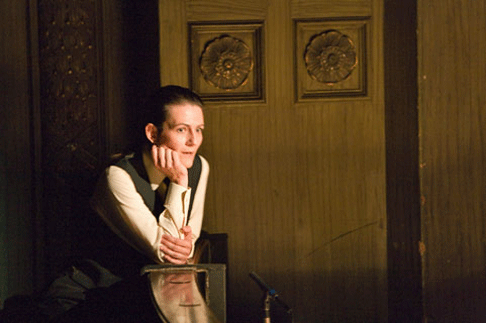 Daniela Sindram as Der Komponist
Daniela Sindram as Der Komponist
The performance took place in the Bayreuth-like art-deco Prinzregenten Theater, the middle-sized of the Bavarian State Opera’s three opera houses, located by Munich’s Isar river.
Raphael Mostel © 2009
image=http://www.operatoday.com/rsys_25820_488ef986301b6.gif image_description=Adrianne Pieczonka as Ariadne and Burkhard Fritz as Bacchus [Photo courtesy of Bavarian State Opera] product=yes product_title=Richard Strauss: Ariadne auf Naxos product_by=Ein Musiklehrer: Martin Gantner; Der Komponist: Daniela Sindram; Bacchus/Der Tenor: Burkhard Fritz; Ein Offizier: Kenneth Roberson; Ein Tanzmeister: Guy de Mey; Ein Perückenmacher: Todd Boyce; Ein Lakai: Christian Rieger; Zerbinetta: Diana Damrau; Ariadne/Primadonna: Adrianne Pieczonka; Harlekin: Nikolay Borchev; Scaramuccio: Ulrich Reß; Truffaldin: Steven Humes; Brighella: Kevin Conners; Najade: Aga Mikolaj; Dryade: Nicole Piccolomini; Echo: Sine Bundgaard. The Bavarian State Orchestra. Conductor Bertrand de Billy. Production: Robert Carsen. Choreography: Marco Santi. Set: Peter Pabst. Costumes: Falk Bauer. Lighting: Manfred Voss. Dramaturgy Ingrid Zellner. product_id=Above: Adrianne Pieczonka as Ariadne and Burkhard Fritz as BacchusPhotos courtesy of Bavarian State Opera
Tosca at the Baths of Caracalla, Rome
In 2008 the Teatro dell’Opera staged thirteen performances of Franco Zeffirelli’s new elaborate staging. In the past twenty years, the Teatro dell’Opera touted productions nearly every other season of Tosca designed by distinguished directors such as Mauro Bolognini and Guiliano Montaldo. The last five seasons of the small “Piccolo Lirico” alone has launched 300 performances of Tosca.
This new adaptation of Tosca is performed in the open theater of the Baths of Caracalla, a magnificent monument. Heritage restrictions do not allow performances within the colossal ruins. Productions, therefore, are staged on a platform in front. Consequently, this limits set changes between the three acts and necessitates minimal changes in props and costumes.
Eduardo Sanchi surrounds the stage with a black-and-white aerial view of modern Rome’s city center. Red circles mark the main locations of the opera: Sant’Andrea della Valle Church, Castel Sant’Angelo and a very red Tiber crossing the stage. This dramatic set serves as the perfect vehicle for the new concept of Tosca. This is not the “blood and guts” drama, as the late Paul Hume wrote when he was the music editor for the Washington Post.
There are plenty of blood and guts, of course, as well as passion and erotic impulses. Yet the focal point of the opera is a new and different one. The staging has the city center crowded with inquisitive priests and clerics throughout the performance, where the oppressively ubiquitous clergy, to paraphrase Anais Nin, are like a vast lead roof which covers the world. Cavaradossi is tortured by the cassock-wearing Scarpia, here a bishop who desperately craves sadistic sex, although it seems that he might be enjoying some young Swiss guard as well as Tosca. There is also one final surprise—Tosca does not jump off the Castel Sant’Angelo’s tower into the river. Instead she drowns in the red Tiber embracing Cavaradossi’s body.
Director Franco Ripa di Meana has a literary basis for these changes. An exchange of letters among Puccini, Illica, Giacosa, and Sardou have been unearthed, revealing an intent of changing the end with a mad scene, Tosca killing Scarpia in a state of madness and then killing herself. Yet Sardou was adamant about the ending, though he had only an approximate idea of Rome, and no knowledge that the Tiber did not flow under Castel Sant’Angelo. In short, the production is strongly anti-clerical, a bit weird, but brilliant!
A funny accident took place on the opening night (July 14th) at the beginning of the third act—a live sheep bleated onstage, serving as counterpoint to the shepherd’s day break song, and a moment of unwanted comic relief in an otherwise tense blood-and-guts, passion-and-sex musical drama.
The usual disclaimer of the difficulties of performing outdoors must be made. And it is to be added that across the street a major political demonstration had been organized. Luckily, they were quite good mannered and did not make excessive noise. The audience could sense that the conductor, Paolo Olmi, was very professional and the orchestra was well familiar with the score.
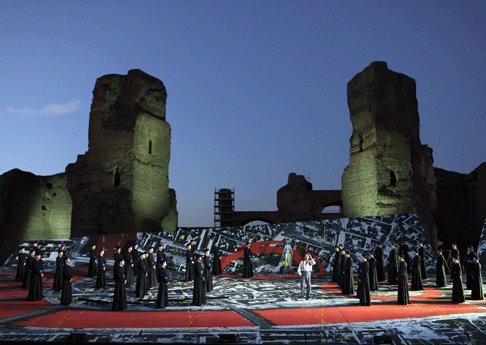
The star of the evening was Fabio Armiliato singing Cavaradossi for the 134th time. His clear timbre, sensual legato, perfect phrasing, physique and skillful acting made him perfect for the role. Michaela Carosi performed Tosca well with a big voice. But diction was poor and, moreover, her second and third act costuming (early 20th century aristocratic gowns) did not suit her well. Giorgio Surian was an effective Scarpia. Roberto Abbondanza deserves special recognition for his interpretation of the Sacrestan, whose comic persona masks his role as a willing abettor of Scarpia’s machinations.
Giuseppe Pennisi
image=http://www.operatoday.com/tosca-roma2009-3.gif image_description=Scene from Tosca [Photo courtesy of Teatro dell'Opera di Roma] product=yes product_title=Giacomo Puccini: Tosca product_by=Floria Tosca: Micaela Carosi (14, 16, 21, 4, 6) / Virginia Todisco (15, 17, 22, 30); Cavaradosi: Fabio Armiliato (14, 16, 21, 4, 6) / Valter Borin (15, 17, 22, 30); Scarpia Giorgio Surian (14, 16, 21, 4, 6) / Giovanni Meoni (15, 17, 22, 30); Sagrestano: Roberto Abbondanza (14, 16, 17, 21, 30) / Carlo Di Cristoforo (15, 22, 4, 6); Angelotti: Alessandro Svab; Spoletta: Mario Bolognesi; Sciarrone: Alessandro Battiato (14, 15, 16, 17, 21) / Antonio Taschini (22, 4) / Riccardo Cortellacci (30, 6); Carceriere: Angelo Nardinocchi (14, 15, 16, 17, 21, 22, 30) / Riccardo Coltellacci (4) / Antonio Taschini (6); Pastorello: Marta Pacifici. Coro di Voci Bianche di Roma dell'Accademia Nazionale di Santa Cecilia e del Teatro dell'Opera. Orchestra e Coro del Teatro Dell’opera. Nuovo allestimento. Maestro concertatore e Direttore: Paolo Olmi. Maestro del Coro: Andrea Giorgi. Regia: Franco Ripa di Meana. Scene: Edoardo Sanchi. Costumi: Silvia Aymonino. Luci: Agostino Angelini. product_id=Above: Scene from ToscaAll photos courtesy of Teatro dell'Opera di Roma
July 20, 2009
Rossini: Il Turco in Italia
Naxos, for example, just released an August 2007 production from the annual Rossini Opera Festival held every summer at the Teatro Rossini in Pesaro. A sort of companion piece to his more popular L’Italiana in Algeri, Il Turco in Italia shares no characters with its better-loved cousin. On the demerit side, it also shares neither L’Italiana’s memorable tunefulness nor relatively comprehensible plot. In Turco, the character of a poet almost serves to break “the fourth wall,” manipulating the other characters into providing the sort of romantic complications that inspire his art. Besides the visiting Turkish prince, a band of gypsies cavorts with the usual young lovers, and “all ends happily,” as the booklet synopsis states.
The booklet essay features too little about this opera in particular, focusing instead on a condensed biography of the composer. It is in the synopsis that Richard Lawrence identifies particular numbers apparently composed by someone other than Rossini, including the opera’s conclusion. Perhaps this particular piece did not elicit from Rossini his top-drawer inspiration, but the score never noticeably sags. A couple of seasons back Covent Garden had a hit with the opera, with a cast led by Cecilia Bartoli. Although mostly attractive and able, a lack of star-power in this Rossini Opera Festival staging mutes some of the piece’s intended charm. As the Turk, Marco Vinco has more voice (a mellow, solid bass) than personality. The roles of the young married couple at the center of the Poet’s amorous shenanigans are performed by Alessandra Marianelli, a pleasant enough voice, and Andrea Concetti, adequate but hardly distinctive. A more impressive tenor appears in the small role of Albazar. Here Daniele Zanfardina shines, especially in a very sweet second act aria. As might come as no surprise, the Poet character wears out his welcome fairly quickly, through no fault of the earnest efforts of Bruno Taddia.
The Teatro Rossini’s small stage is not exactly crowded with Paolo Bregni’s sets. A bare stone platform, perhaps resembling a wharf, serves for most of the action. A more elaborate setting for Donna Fiorella’s home provides the eye with some distraction. Santuzza Cali’s costumes are colorful if conventional. Guido De Monticelli, the director, keeps things moving, if without much inspiration.
Antonello Allemandi conducts an ensemble with the wonderful name of Orchestra Haydn di Bolzano e Trento. Naxos provides the musicians with crisp, clean sound for their energetic efforts.
Not an outstanding release, then, but a fine summer distraction, and at the Naxos price, much less damage to one’s pocketbook than a trip to Pesaro.
Chris Mullins
image=http://www.operatoday.com/Naxos2.110259.gif imagedescription=Gioachino Rossini: Il Turco in Italia
product=yes producttitle=Gioachino Rossini: Il Turco in Italia productby=Selim: Marco Vinco; Fiorilla: Alessandra Marianelli; Geronio: Andrea Concetti; Narciso: Filippo Adami; Prosdocimo: Bruno Taddia; Zaida: Elena Belfiore; Albazar: Daniele Zanfardino. Prague Chamber Choir. Orchestra Haydn di Bolzano e Trento. Antonello Allemandi, conductor. Guido De Monticelli, stage director. productid=Naxos 2.110259 [DVD] price=$26.99 producturl=http://astore.amazon.com/operatoday-20/detail/B001LKLKLG
Munich's Re-constructed Lohengrin
Interest was extremely high, of course, in local boy Jonas Kaufmann’s first take on the title role. We were amply rewarded. For Mr. Kaufmann has it all, the mettle and the metal, starting with a robust, baritonal timbre in mid and low-range that loses none of its buzz as he ascends above the staff. His sound technique and focused tone allow him to not only ride the full orchestra as required, but also to scale back to intense, melting piano singing that lovingly caresses the more tender and introspective moments. If In fernem Land had been any more hushed or unearthly beautiful, my heart would likely have stopped. Magnificent.
Add to this, the fact that Jonas is strappingly handsome, eminently stage-wise, and always engaged with his colleagues, and you begin to know that this is a major star in a major step forward in his career (although maybe he should resist doing the part in a house larger than the Staatsoper until he sees how it wears on him). You can also understand why savvy record promoters would perch him atop a mist shrouded summit, Caspar-David-Friedrich-like on the cover photo of his new CD release and declare him “Germany’s most beautiful voice.” The partisan Munich crowd who loudly celebrated his achievement would have agreed.
But they might have argued that German soprano Anja Harteros could also be a worthy target of that encomium. I had greatly admired her Elisabetta in the Oslo Don Carlo but as wonderful as that was, her Elsa could be rightly called ‘definitive.’ Ms. Harteros has a creamy sound production of some gravity that serves her well in all registers. As she flawlessly negotiated every demand of this rangy part, I was reminded of a singer friend who once assessed a performance of Kiri Te Kanawa with mock jealousy, saying “Damn, make a mistake girl!”
But this our soprano did not do, regaling us with a text-book display of impassioned, controlled, varied, yet always lyrical Wagnerian styling. It was interesting too that her voice had been so Italianate in the Verdi, yet here was sometimes deployed with straighter tone, in more conversational delivery. She also looked beautiful, and was a vibrant stage creature that perfectly complemented her leading man. This pairing of Kaufmann and Harteros will likely be celebrated by aficionados for a long time to come.
But although the duo set the bar very high indeed, the rest of the cast was up to challenge. Wolfgang Koch beautifully sang the role of Telramund with an incisive baritone, making music of the many outbursts that most usually shout. Michaela Schuster blazed through Ortrud with relish and imposing vocalism. If her securely hurled upper phrases occasionally tended toward stridency, it perfectly suited this character, and contrasted well with the pristine Elsa. As usual, Christoff Fischesser was reliably solid as the King, and in what is rather a throw-away role, Evgeny Nikitin was a surprising treat with his well-sung Herald.
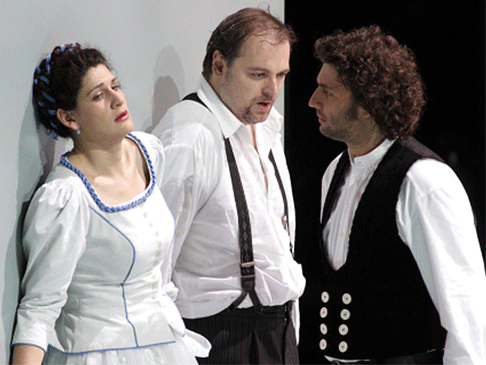
To say that the orchestra had the finest night I have yet heard from this talented band is a credit to the consummate leadership of conductor Kent Nagano. It is hard to believe that this was my first “live” encounter with the maestro, but it will not be my last. Mr. Nagano led a seamless reading, eliciting spot-on ensemble attaci from all the banks of instruments (especially in those difficult expansive unfolding preludes). The brass were in fine form — nay thrilling form — and the strings just glowed as they poured out arching phrase after arching phrase. The maestro’s attention to detail highlighted several voicings and solos that were absolutely fresh and pleasing to discover.
It was curious that, having snuck onto the podium for Acts One and Two, negating audience “entrance” applause, Mr. Nagano threw that to the winds for a triumphal march into the pit at the start of Three. If he was, as I suspect, approximating the Bayreuth experience (where we don’t see the conductor until the call), why not be consistent? But that is minor, extra-musical carping. The orchestra under Kent Nagano (and chorus, directed by Andrés Máspero) were world-class, festival-class, you-name-it-class … they were of the highest class.
As for the direction by Richard Jones and the physical production, I find there is much good to be said. Mr. Jones took as his central “Konzept” an idea that Elsa aspires to be a proponent of ideals for the “construction” of a new order as the country was perched on the verge of civil war. Mr. Jones realized his metaphor as a literal “construction” of (what turns out to be) Elsa’s and Lohengrin’s Wedding House. (It must be said the stage management and running crew did remarkably fine work all night long.)
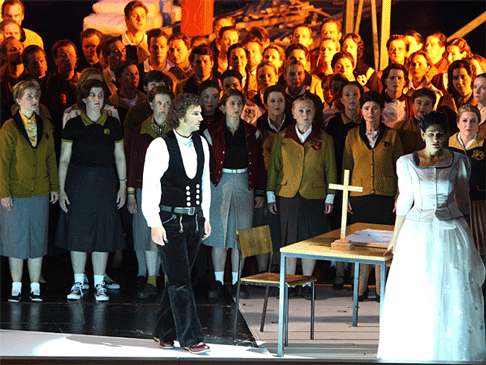
Whatever one might think of the process of watching this house (aka new social order) get actually built over the course of the opera, or of having Elsa in work clothes laying bricks, this was a hugely impressive set design from Ultz, who also contributed the effective costumes. By the end of Act Two, a complete two-story chalet with balcony has been constructed and a turntable spins it around for us to admire.
And then … even as it spun … the vociferous catcalls began. (Oh, dear, and a whole act to go!) I can appreciate that the visual embodiment of the “construction” may have been heavy handed, and that some may have wished for a design more akin to a period Belgian tapestry (and perhaps Lauritz Melchior back to sing in it), but really, I found that this was a handsome, very polished design that was considerate and consistent.
Moreover, it was beautifully lit by Mimi Jordan Sherin, who took advantage of its natural color to unleash a full palette of evocative lighting effects on it, abetted by videographer Silke Holzach. Only the projection of the rising horizontal green and black lines (like an old TV test pattern) was of perplexing intent.
Director Jones was a master of clarity and focus. All the while the stage was peopled with extras building the house, we were never distracted, and the characters always interacted meaningfully. Among the beautiful touches was having Lohengrin arrive bearing the swan as if being led by it. And having him carry a baby crib to the wedding house’s upstairs room, only later to put it on the bed and torch it, after Elsa’s betrayal (shades of Waco!).
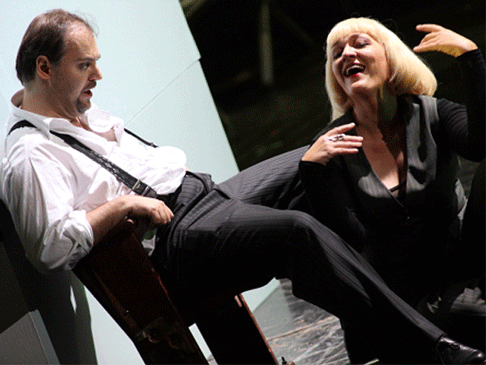
In fact, cultism seemed to be more the new order than any ideal of Elsa’s. At the start, the citizens were dressed in stylized blazers and faux folk dress, with the men’s hair swept up and out like an old hood ornament on a Chrysler. Very Flemish kitsch-inspired. Then Lohengrin arrived in a modern pale blue tee shirt and jogging pants with a silver stripe. In a visual irony, the citizenry became converts to Lohengrin/Elsa and donned blue tees, while the love couple got wed in rather traditional folk dress. As Ortrud offed herself and the chorus followed suit, there were echoes of Jonestown, underscoring the occasional peril of following charismatic leaders. This was richly complicated imagery and it not only complemented Wagner, but really it represented his intent.
Did everything work? No. The goofy duel between Lohengrin and Telramund looked like un-coordinated pre-pubescent boys flailing Star Wars light sabers. And the moment misfired when Telramund rushed in to murder the hero, with Elsa standing on the wedding bed and brandishing a sword, and Telramund falling dead without having come anywhere near the lethal weapon. Spatially, it made no visual sense.
Still, at the end of the day, this Lohengrin was always interesting, if occasionally flawed work from a very talented production team, well served by a cast and orchestra who were utter perfection. And isn’t that ample cause for rejoicing?
James Sohre
image=http://www.operatoday.com/LohengrinMunich200903.gif imagedescription=Scene from Lohengrin [Photo by W. Hösl courtesy of Bayerische Staatsoper]
product=yes
producttitle=Richard Wagner: Lohengrin
productby=Heinrich der Vogler: Christof Fischesser; Lohengrin: Jonas Kaufmann; Elsa von Brabant: Anja Harteros; Friedrich von Telramund: Wolfgang Koch; Ortrud: Michaela Schuster; Heerrufer des Königs: Evgeny Nikitin; Edler 1 / Brabantischer Edle: Francesco Petrozzi; Edler 2 / Brabantischer Edle: Kenneth Roberson; Edler 3 / Brabantischer Edle: Christopher Magiera; Edler 4 / Brabantischer Edle: Igor Bakan; 4 Edelknaben: Tölzer Knabenchor. Bayerisches Staatsorchester. Chor der Bayerischen Staatsoper. Musikalische Leitung: Kent Nagano. Inszenierung: Richard Jones. Bühne und Kostüme: Ultz; Licht: Mimi Jordan Sherin. Chöre: Andrés Máspero.
product_id=Above: Scene from Lohengrin
All photos by W. Hösl courtesy of Bayerische Staatsoper
July 19, 2009
Alice Coote stars in the First Night of the BBC Proms 2009
The atmosphere at the First Night is electric, everyone’s in a party mood. Yet the high point of this Prom was Alice Coote’s stunning Brahms’s Alto Rhapsody, op. 53, heard for the first time at the Royal Albert Hall in 41 years.
The Prom began with Stravinsky’s Fireworks, op 4. It’s a bagatelle, but Diaghilev liked it so much he commissioned The Firebird and then The Rite of Spring. So from this acorn grew modern music. Not even the carnage of the First World War could stem the tide. This year’s Proms will feature all of Stravinsky’s ballets.
Chabrier’s Ode to Music followed. Ailish Tynan has been on many Young Artist programs, many of which were BBC funded and promoted. She’s proof that such sponsorship nurtures performers. It must be nerve wracking to sing before an audience of millions, so Jiřì Belohlàvek led the BBC Symphony Orchestra sensitively. Belohlàvek is proving a revelation in London music circles. He has no equal in Czech and Slavic repertoire. Recently his Dvořàk’s Rusalka at Glyndebourne won great acclaim. At last year’s Proms, he produced a superlative Janàček Osud. This year he’ll be conducting Smetana and Martinů.
Tchaikovsky’s Piano Concerto no 3 is another acorn, but one which didn’t grow past its first movement. Yet it’s interesting because it shows how full of life the composer was just before he died. No “curse of the Pathétique”, then. This rarity was a surprising choice for something as high profile as the First Night of the Proms, when the audience is happy with flashy crowd pleasers. But in a quirky way, that’s why it worked. The Proms may appear safe, but there’s enough challenge for those prepared to venture.
Back to fireworks with Katia and Marielle Labèque. Poulenc’s Concerto in D minor for two pianos is a three part drama, an interplay between two different pianists and orchestra, with individual instruments playing smaller supporting roles. Moods swing between tender and jazzy, from elegant serenity to uninhibited joy. For an encore, the Labèques then played four hands on one keyboard, a lively polka by Berio - not Luciano but his grandfather. Another Proms surprise !
International as the Proms may be, they symbolize Britishness to many, so it was good to hear Elgar, in sunny mode, In the South played with élan.
The heart of this Prom, though, wasn’t the obvious cheerful pieces but Brahms’s devastating Rhapsody for Contralto, the Alto Rhapsody. Alice Coote’s performance was searing, white hot with intensity, without sacrificing the compassion and dignity that makes the piece so moving.
Goethe’s poem depicts an outcast who sets off away into the wilderness. From a brooding orchestral introduction, Coote’s voice projects into the vastness of the Royal Albert Hall. It’s important that she has such command, for the poem pits an individual against overwhelming forces. “Die Ode verschlingt ihn” goes the text, “the desert engulfs him”. Coote breathed into the “o” in “Ode” so it rang resonantly, yet hinted subtly of the hollowness within. Then she extended “verschlingt”, stretching it to evoke distance and then oblivion.
There’s something neurotic about this poem. The disappointed man “furtively feeds on his own worth in unfulfilling self-love”. (“zehrt er heimlich auf seinen eignen Wert in ung’nügender Selbstsucht”). Coote showed how the repeated sounds “seinen” and “eignen” elucidate meaning. The protagonist is going round in circles, grinding himself down. Maybe that’s why the poem appealed to Brahms? Ostensibly he was upset that he’d been jilted by Clara Schumann’s daughter but there’s no evidence that he had a real relationship with her, or indeed with any woman, Clara included.
Perhaps that’s why the resolution in this piece comes from the way Brahms integrates the soloist, chorus and orchestra. A characteristic Brahmsian flute melody appears, at first tentatively, then grows in power, joined in the final strophe with the choir of men’s voices : no longer is the mezzo really alone, for the Vater der Liebe (father of love, possibly God) has shown mercy, revealing the “thousand springs that can help the thirsty in the desert” (“die tausend Quellen neben dem Durstenden in der Wüste”) Coote rounds the vowel sounds in “Wüste” making the word grow with as if absorbing nourishment.
The Alto Rhapsody is a powerful work, Brahms’s Winterreise, if you will, heralding the even more profound Vier ernste Gesänge, op. 121. After a performance like this it was hard to take in anything else.
All Proms are available for listening online and on demand on the BBC Proms website. The First Night was televised so there’s also a video upload, Over the next few weeks, Opera Today will be covering Proms of opera and vocal interest, including a new Handel Partenope (with Andreas Scholl) and Purcell’s The Fairy Queen. a semi staging of the current Glyndebourne production reviewed in June.
Anne Ozorio
Click here to access the BBC Proms web site.
image=http://www.operatoday.com/anne-marie-le-ble.gif image_description=Alice Coote [Photo by Anne-Marie Le Blé]
product=yes
producttitle=BBC Proms: 17th July, 2009, Royal Albert Hall, London
Stravinsky: Fireworks; Chabrier: Ode to Music; Tchaikovsky: Piano Concerto No 3; Poulenc: Concerto in D minor for two pianos; Elgar: In the South; Brahms: Alto Rhapsody; Bruckner: Psalm 150.
productby=Alice Coote (mezzo-soprano), Ailish Tynan (soprano), Stephen Hough (piano), Katia and Marielle Labèque (pianos), BBC Singers, BBC Symphony Orchestra, Jiřì Belohlàvek (conductor)
product_id=Above: Alice Coote [Photo by Anne-Marie Blé]
Festival Aix-en-Provence by Stéphan Lissner
This summer (July 3 - 31, 2009) is its sixty-first edition, though perhaps more importantly it is the twelfth edition of the Festival as re-invented by Stéphan Lissner. The Festival is now overseen by Bernard Foccroulle as Mr. Lissner has assumed the higher calling of setting things straight at Milan’s La Scala.
Miracles wrought by Mr. Lissner in his nine years at the helm in Aix (1998 - 2006) include revamping the Festival’s signature performing space, the open air 1300 seat Théâtre d’Archeveché, the construction of the Grand Théåtre de Provence, a 1400 seat indoor multi-purpose theater capable of hosting fairly large scale opera productions, the revitalization of a small, old Italian style theater, the Jeu de Paume for Festival use, inaugurating use of the Grand Saint Jean countryside park a few kilometers from Aix for small, technically simple productions, and establishing a facility for scenic construction. Whew.
Mr. Lissner conceived the Académie Européenne de Musique that has grown to include workshops in opera, lieder, chamber music, and opera production during the festival period (this summer there are eighty-five participants and a faculty of thirty). And he has conceived such magnificent opera projects as a Stéphane Braunschweig production of Wagner’s Ring with the Berlin Philharmonic and Sir Simon Rattle in the pit. This summer was its final installment, four performances of Götterdämmerung. Wow.
An enormous accomplishment indeed, though all that was lacking was good opera. Mr. Lissner’s artistic Ideas were pretentious, productions were ill-conceived, and performances were mediocre. It is hard to think of exceptions though surely there must have been some. Meanwhile the predominately French audiences did not seem to mind, as they flocked to performances. Go figure.
This summer, the third festival guided by Bernard Foccroulle, offers glimmers of hope that the tide has turned, this hope based on two productions seen in its opening days, Mozart’s Idomeneo and Offenbach’s Orphée aux Enfers. The Idomeneo was just what a festival production should be — one well beyond the scope of an ordinary season of opera. The orchestra was Les Musiciens du Louvre - Grenoble, playing on period instruments, the conductor Marc Minkowski is a specialist in period style. The production, by Olivier Py, pushed the envelope with huge, stilt-legged, light metal platform constructions that were in continuous, balletic motion, no electronically controlled horsepower here, only the flexed muscles and sweat of ten (or so) formally dressed, athletic grips (stagehands), these classy oversized nibelungens always in full, working view.
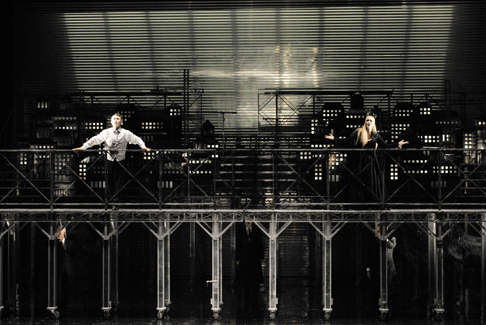 A scene from Idomeneo
A scene from Idomeneo
Three and one half hours into the performance (performances begin a dusk, 9:30 PM, thus at 1 AM) we hit the ballet. Not only did the set elements begin to fly, i.e. move wildly around the stage, seven dancers retold the entire story in frenetic, fast forward pantomime for a final fifteen minutes. Then the house came down, including some French inflected boos (hoos in French). And the final curtain descended to a huge whoop from backstage — relief and pleasure that they had achieved a miracle, a flawless (or so it seemed) convergence of a myriad of elements realized against all possible odds.
The cast were fine young singers who continuously inter-played in complex staging with the monumental buildings of Crete, Idomeneo its shirt-sleaves-rolled-up master builder. Eminently striking was the use of a tenor voice for Idamante, Mozart’s original counter-tenor — the French back then and now too apparently never cottoning up to male mutilation even for artistic purposes. Absence of cross dressing (the mezzo as male) also makes story telling more direct these days though changing the clef (tessitura) of this voice robbed its music of much of its power.
Olivier Py’s concept was naive, if blatant — white and black, i.e. modern dressed Europeans and versus Africans in modern countryside regalia. Illa was a beautiful young singer of vaguely African origins, her dancer counterpart for the ballet was a lithely beautiful Black nymph, plus three strong, young black dancer warriors and two Brown Cretans. Not to mention a few real African figurants (supers). Of course the dynamic between Europeans and Africans is far from that of the Cretans and the Thebians so this heavy-handed social commentary look was far from appropriate. But who cares, the performance was magnificent.
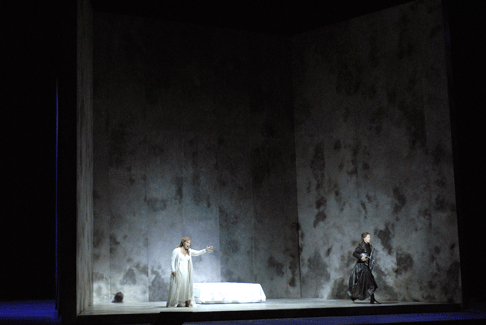 A scene from Götterdämmerung
A scene from Götterdämmerung
When it was all over suspicions arose that we had not heard the piece, short of a couple of show-stopping arias in the first act, the famous third act quartet having been lost amongst the choreography of the singers moving within the moving set. But this suspicion was quickly supplanted by the notion that this had been a true gesamtkunstwerk, a synthesis of all the arts that make opera — the rigid and controlled tempos appropriate to Baroque musical structures were realized on the primitive versions of modern instruments melting into the stark architectural structures moving dance like on the stage together with the supple bodies and pure young voices of idealized Mozartian singers. This production was proof that this Mozart opera transcends its music.
Operas in Aix are largely about conducting and staging. Less about singing. The price of a single ticket indicates what to expect. Ring tickets cost 350 euros each ($525), the singers biographies ticking off Bayreuth, Vienna, the Metropolitan Opera, Covent Garden, etc. Idomeneo tickets cost 210 euros ($315), its singers mixing often substantial major theater credits with important regional opera house credits, and finally the 170 euros ($255) price of an Orphée aux Enfers ticket provides entry level professionals and the occasional alumnus of the Aix Festival’s Académie programs.
The lower ticket price does not mean lesser attention to conducting and production, the Orphée aux Enfers as case in point. The show was in the pit, conductor Alain Altinoglu whipped up the Camerata Salzburg orchestra, here forty some players (more or less the number Offenbach used at the Theatre des Bouffes Parisienne in 1858 into a frenzy of amusing musical details that graciously titillated the far-from-subtle satire of Second Empire life. This lively young conducting star moved the musical action along at a comfortable, always lively toe-tapping pace until the can-can, taken at its fitting breakneck speed and danced (sort of) by everyone on stage (real dancers need slower tempi because they kick much higher).
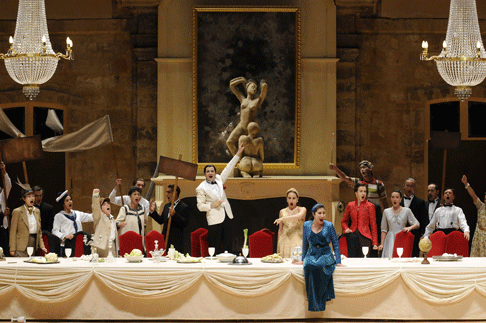 A scene from Orphée aux Enfers
A scene from Orphée aux Enfers
The fun was in the pit, far more than on the stage, the young singers, some less able than others to substantiate the larger-than-life personalities of Offenbach’s Olympian personalities. This however was the strength of Yves Beaunesne’s production. The young artists did what they could do without the usual overload of opera-stars-having-fun. Truly exceptional was the virtuoso violin mimicking of Orphée (Julien Behr) and the opera comedy monologue inserted by John Styx (Jérôme Billy) that had the audience and the orchestra (especially Mo. Altinoglu) in stitches.
The modest, and truly intelligent tone of the production was perfection, as it let the personalities of these charming young artists shine. There was no attempt to magnify the humor, to push to show over-the-top. Decors were cleverly created to capture the modesty of production of this first Offenbach operetta (this first version succeeding far more than its later Offenbach re-make, and countless productions since, all seeking to make the operetta fun when it already is — just ask Mo. Altinoglu). l The Olympus scenes were especially effective, a grand dinner party using the architectural elements of the facade of the old Episcopal palace, (now the back wall of the theater) bathed in a sickly yellow-gold light that was un-enviably other-worldly, with the drugged-out Olympians in gorgeous formal dress strewn about the stage (the costumer, Patrice Cauchetier wore a cream colored shirt printed with luscious giant red roses for the opening night bows).
The Götterdämmerung was, one assumes, a legacy of the Lissner regime. Stéphane Braunschweig is a director/designer, thus in principal achieves one unified vision without the distraction of collaboration. Mr. Braunschweig bestowed an exquisitely beautiful, ultra minimalist look (elevators rose and descended creating basic stair, bench, pit forms) evoked distilled abstractions of locale, the forest was an abstract sculpture of five, tall narrow trees. Mr. Braunschweig did not burden his “look” with a conception, his minimally costumed (basic black or white generic male or female shapes, save Siegfried who was in brown plaid) actors played Wagner’s domestic comedy in clean, very precise movements and placement, often with toes touching the edge of the downstage, i.e. facing directly into the hall. This very effective trick did not always work well. Brünnhilde stood there way too long while what we wanted was to see some real fire consume her.
This minimalist staging, believe it or not, held its own much of the time just above the splendor of the Berlin Philharmonic seated just below, Sir Simon Rattle pulling forth the Wagnerian leitmotifs with a purity of tone that seemed the primal discovery of mythic drama. This created a dramatic reality for the actors that heightened their sordid humanity, the soap opera baseness overcome by the solemnity of the music of Wagnerian philosophy. While true poetry sometimes emerged from the pit — the brass choir sang the break of day with splendid purity — little poetry was projected from the stage, the out-of-place realistic video of spring water undermined the usual poetic innocence of the charming encounter of the Rhine Maidens with Siegfried at the beginning of the third act.
When finally the medium sized square of video flames subsided, we saw the chorus dressed in shining white formal wear gazing down into a huge geometric pit that had opened through the floor of the stage. One longed for a Calixto Bieito resolution where the chorus would surely be naked (obligatoire), and where there would be an outhouse nearby (obligatoire) to make Wagner’s purified humanity even more primal, and to make our encounter with this nineteenth century artistic monument a real one.
It was, of course, Cadillac casting — fine singing actors who perform these roles on the world’s great stages, including Ben Heppner who was a fish out of water in this high “look” production.
Three operas in three days, a fourth to come later in the month. Imagine an Austrian orchestra, a French one no to mention the hundred and twenty of so players of the Berlin Philharmonic (not counting the five extra harps for Götterdämmerung), plus the Rundfunkchor Berlin, three full-scale, technically demanding productions and a host of opera singers plus the Académie participants, all this stuffed into this large town in the south of France, arguably the most charming town in France if not on earth. And there still seems plenty of room for capacity audiences at this true European cultural crossroad.
This month-long festival, operating on a budget of 20,000,000 euros ($30,000,000), is amazing indeed.
Michael Milenski
image=http://www.operatoday.com/06-19Or505.gif image_description=A scene from Orphée aux Enfers [Photo by E. Carrechio courtesy of Festival d'Aix-en-Provence] product=yes product_title=Festival Aix-en-Provence by Stéphan Lissner product_by=Richard Wagner: GötterdämmerungW. A. Mozart: Idomeneo
Jacques Offenbach: Orphée aux Enfers product_id=Above: A scene from Orphée aux Enfers
All photos by E. Carrechio courtesy of Festival d'Aix-en-Provence
Götterdämmerung at Aix-en-Provence — A Human Symphony
Its minimalist design by Stéphane Braunschweig (stage direction and sets), Thibault Vancraenenbroeck (costumes) and Marion Hewlett (lighting) notwithstanding, this production delivers a compelling musical drama that focuses on the human condition.
This production of the Ring is an important step forward in the interpretation of Wagner’s musical drama. Absent are the clichés of characters dressed as Nazis (or as Eastern German soldiers in the recent Knöll production in Venice). Absent is the bewildering “balance” between science fiction and poetry as in the recent La Fura production in Florence or the absurdly ridiculous staging in Lisbon that employed a circus ring. Absent, too, are cardboard reproductions of medieval German forests, rivers and royal palaces as imagined by late 19th century intellectuals.
Rather, we finally have a psychological reading of the Ring that emphasizes the interpersonal relationships of the dramatis personae. The staging is minimalist. The sets consist of three walls, a window and a staircase, along with a few abstract. The props are three chairs, a leather armchair and two beds. Lighting and acting (what a quality of acting!) do the rest, keeping the audience on the edge of their seats for nearly 6 hours.
A key element of Götterdämmerung, as with the Ring as a whole, is the sequence of leitmotifs associated with a character, a place, an event, an object and so on. The Prologue begins with the sequence expressing primal nature and the Rhine (No. 2), Erda (No. 42) and then the Annunciation of Death (No. 83B). A new leitmotif (No. 154) is introduced as the Norns appear weaving the ropes of destiny, discussing past events, the doom of the gods, the curse of the Niebelung’s Ring, questioning the nature of a distant gleam of light (is it fire or is it dawn?).* The Norns then disappear and dawn breaks. With the radiant tonality of daybreak, Brünhilde and Siegfried emerge after a joyous night of love-making. We could not be more directly assured that we are no longer in a world of gods, giants, dwarves, dragons and demigods. We are in a universe of men and women where mist and the darkness are contrasted against light and the radiance. Light and radiance win. Thus, after nearly 6 hours, the turmoil of the downfall of the gods segues to the leitmotif of redemption by love — the old order is shattered, a glorious new world is revealed.
Earlier productions stressed that the men and women in Götterdämmerung stand alone with their problems (intrigues of power and wealth) and their passions. Valhalla (with its gods and goddesses) is at a distance. In this production, Wotan appears silently at the very end as the Wanderer to witness the demise of “his” world — the old order. The human psychological content of the Ring, and especially of Götterdämmerung, is central to this production as conceived by Bruanschweig, Vancraenenbroeck and Hewlett.
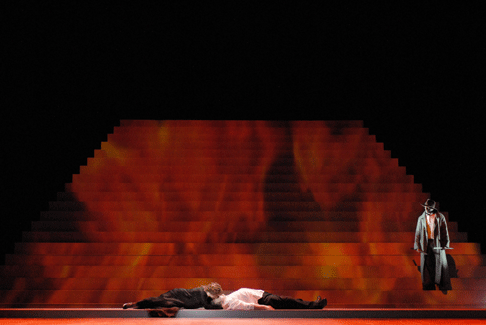
Another key to a successful production of the Ring is the orchestra. Wagner thought of the Ring not as a cycle of operas (a rather normal practice in 19th century Germany) but as a festival drama (where each and every word had to be understood) with a symphony orchestra concealed in a pit under the stage (not to be seen by the audience). Sir Simon Rattle and the Berliner Philarmoniker transform Götterdämmerung into a symphony of humanity searching for a better world — independent of the intrigues of the gods, of the kings, of the dwarves, of the demigods and the like. A similar symphonic treatment had been attempted in the mid-1970s by the Washington National Opera in a production of Die Walküre (with Roberta Knie at the height of her splendour). But the staging was the traditional primeval Germany wrought in cardboard. And, with due respect to Antal Dorati, the Washington National Symphony never possessed the high standard of quality as that of the Berliner Philarmoniker. Sir Simon Rattle and his orchestra have greater skills than most other orchestras in finding the right musical colours, the gentle nuances, the always vivid imagination, especially the ability to slide from a chamber music Wagner (e.g. Solti, Böhm) to a highly dramatic , black, tragic Wagner (e.g. Boulez, Sinopoli, von Karajan, Fürtwangler). This is a Ring, and a Götterdämmerung, that demands many listenings to appreciate the symphonic rigor and impact produced by Rattle and company. A detail: there are six harps, as required by Wagner, which are placed just at the centre of the orchestra under the stage. “Normal” productions make do with two harps, often in a side box.
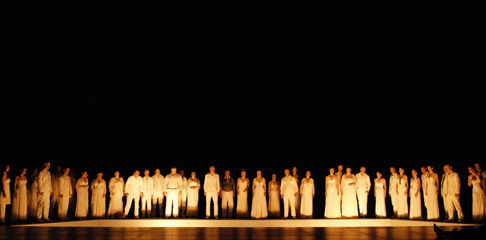
This Götterdämmerung benefitted from great acting and singing. At the age of 55, Ben Heppner is a naïve Siegfried. The role is taxing, but his voice maintained a magnificently crystal clear timbre and exhibited superb phrasing, a moving legato and the ability to reach high C and F. Next to him, Katarina Dalayma as Brünhilde displayed full vocal and dramatic power. Her performance was particularly impressive in the holocaust of the final scene. An ever young and attractive Anne Sophie von Otter appeared as Waltraute, the desperate Walkürie tortured by the looming end of the world. The vocally and dramatically promising Emma Vetter was a whorish Gutrune. As Hagen, an impressive Mikhail Petrenko presented a character that was devilish, astute, even more evil than his father Alberich (Dale Duesing). The Norns and the Rhinemaidens (Maria Radner, Lilli Paasiviki, Miranda Keys, Anna Siminska, Eva Vogel) were all top-notch.
In short, if you missed this Götterdämmerung in Provence, it is worth traveling to Salzburg for performances to be held there next Easter. Moreover, a recording of this production is in process. Look for it in your music store.
Giuseppe Pennisi
*[Editor’s Note: The description and numbering of leitmotifs are based on Ernest Newman, The Wagner Operas 591-594 (Princeton Univ. Press 1949). The numbering of the leitmotifs, however, varies from source to source. Compare Ernst von Wolzogen, Guide through the music of “The Ring of the Nibelung” by Richard Wagner (Feodor Reinboth N.D.). It should be noted, however, that Barry Millington cautions against labeling leitmotifs because the context in which they appear rarely admits a consistently unequivocal meaning. Stewart Spencer & Barry Millington, Wagner’s Ring of the Nibelung — A Companion 14-24 (Thames & Hudson 1993).]
image=http://www.operatoday.com/Richard_Wagner_by_Caesar_Wi.gif image_description=Richard Wagner product=yes product_title=Richard Wagner: Götterdämmerung product_by=Siegfried: Ben Heppner; Gunther: Gerd Grochowski; Hagen: Mikhail Petrenko; Alberich: Dale Duising; Brünnhilde: Katarina Dalayman; Gutrune : Emma Vetter; Waltraute: Anne Sophie von Hotter; First Norn: Maria Radner; Second Norn: Lilli Paasikivi; Third Norn: Miranda Keys; Woglinde: Sara Fox; Wellgunde: Eva Vogel; Maria Radner: Annette Jahns product_id=Photos by Elisabeth Carecchio courtesy of Festival d'Aix en ProvenceMozart Mistreated at Aix-en-Provence Festival
Nevertheless, Mozart has always been the core of the Festival repertory and the new production of “Idomeneo” did look good on paper. The opera has 6 performances, from July 4 through 17, in the traditional venue, the courtyard of the Archbishop’s palace in Aix.
Director Olivier Py has been heaped with praise for his work with Geneva’s opera for the past several years. Recently appointed to head the top Odéon–Théâtre de l’Europe in Paris (where the great Giorgio Strehler did much of his best work) he seemed a theater god who could do no wrong. This lumpy, limping production, however, suggests a serious case of clay feet.
First seen on stage are well-dressed African boat people (the Trojan prisoners in the libretto) who are menaced by AK-47 men in black for no particular reason. The story-telling did not improve later. Using massive amounts of structural steel, one critic commented that it was like Mozart meeting Gustav Eiffel. Actually, it was Eiffel who consistently demonstrated how light and graceful steel structures could be. Py’s “heavy metal” approach was oppressive to to the eye and garishly lit. The ungainly sections were on wheels and, during duets, couples were compelled to sing while ascend stairs and open doors of the twirling sections, all the while negotiating Mozartian rapids. The usually-cut ballet sequences (there was no choreographer credited in the program) had half-naked young men camping it up when they were not pretending to dismember each other and it reminding this writer of Madonna’s back-up dancers on tour.
Vocally, it is not promising when the singer with a real feel for the Mozartian style is the Arbace. Very impressive here, young Xavier Mas is clearly one to track. In the title role, tenor Richard Croft (Mozart’s 1789 tenor version was used) had often fine moments and his “Fuor del mar” was well received. Strain, however, was always apparent when the music went “forte” and beyond. French tenor Yann Beuron, as Idamante, has had his voice fill out and thicken these past years and, while still lovely, it no longer has easily agility. The talented Belgian soprano Sophie Karthäuser impressed as Ilia but, as with the decor, less steel would have been better.
When the grand Mireille Delunsch first descended the staircase as Elettra there was an electricity in her voice that demanded attention. But, reaching stage level and directorial requirements — silent-screen gesticulations that would have embarrassed Theda Bara — all hope of a definitive character disappeared. Later, during her final scene, there actually was a bucket of blood and she went ahead with the sponge bath, putting to rest the French idea of “du trop.” The Neptune — almost always on stage waiving his trident — was wearing what appeared to be a bargain Halloween costume from Woolworths.
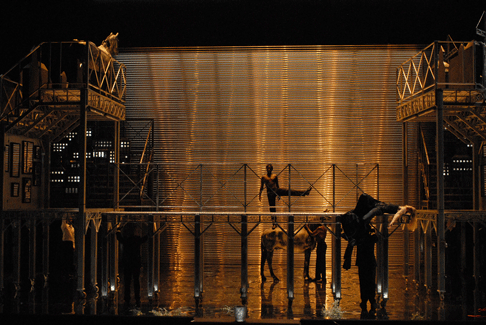 A scene from Idomeneo [Photo by E. Carrechio courtesy of Festival d'Aix-en-Provence
A scene from Idomeneo [Photo by E. Carrechio courtesy of Festival d'Aix-en-Provence
The singing, while not up to highest festival standards, served the music and Marc Minkowski and his Musiciens du Louvre-Grenoble contributed a strong orchestral underpinning with their traditional gusto. A few orchestral sour notes could be attributed to the changing humidity as night falls — a traditional problem with outdoor concerts. This opera of the 25 year-old composer has been receiving much attention in recent years with, as only one example, a fine new production of Luc Bondy at the Paris Opera. The Aix production, broadcast throughout Europe on the night I saw it, July 10, is not likely to induce a flood of ticket request for next season. This is an extraordinary opera and a cumbersome staging does not show the music to best advantage.
Frank Cadenhead
This article first appeared in La Scena Musicale. It is reprinted with the permission of the author.
image=http://www.operatoday.com/Delunsch_Elettra.gif image_description=Mireille Delunsch as Elettra product=yes product_title=W. A. Mozart: Idomeneo product_by=Idomeneo: Richard Croft; Idamante: Yann Beuron; Ilia: Sophie Karthäuser; Elettra: Mireille Delunsch; Arbace: Xavier Mas; Gran sacerdote di Nettuno: Colin Balzer; La Voce: Luca Tittoto. Choeur Rundfunkchor Berlin / Choeur de la Radio de Berlin. Chef de coeur: Simon Halsey. Orchestre Musiciens du Louvre.Grenoble. Direction musicale: Marc Minkowski. Mise en scène et lumières: Olivier Py. Scénographie et costumes: Pierre André Weitz. product_id=Above: Mireille Delunsch as ElettraProm 2 — Haydn: The Creation
Evidently one shared by the Proms audience last night, although if we dream of the creation of the world it’s probably more likely to be in the more usually heard German edition — given Paul McCreesh’s advocacy of his own revised version it seems churlish to voice this, but there’s something about, say, ‘Mit Würd und Hoheit angetan’ which ‘In native worth and honour clad’ just doesn’t have.
What this performance did have, was stirring singing from the massed forces of Chetham’s Chamber Choir, members of the Wroclaw Philharmonic Choir, and the Gabrieli Consort, and mostly stellar playing from the Gabrieli Players, with especially strong contributions from Katy Bircher’s flute and the Fortepiano of Benjamin Bayl. McCreesh has a dynamic view of the piece: it’s all dappled shade followed by blazing light, with tremendous climaxes at the exalted, Handelian closing choruses, ‘Achieved is the glorious work’ being especially powerful. He handles the intimacy of the solo parts well too, giving space to shape the phrases and savour the language.
If I have doubts about this evening, they lie with the singers: far be it from me to argue with how solo passages are managed, but it did seem odd to me that poor old Adam and Eve had to sit there for two thirds of the time before they were created — aren’t those parts usually sung by the Gabriel and Raphael? As for their singing, of course it is always lovely to hear Peter Harvey’s refined bass, and Sophie Bevan has been delighting me for years ever since I heard her RCM debut: their duet ‘With thee is every joy enhanced’ was very engaging.
Rosemary Joshua was the vocal star of course, her genuine Handelian soprano making light work of the onomatopoeic trills of ‘On mighty pens uplifted soars’ and providing exactly the right sense of sparkling lightness at ‘The glorious heav’nly hierarchy.’ Beside her, Neal Davies’ workmanlike Raphael and Mark Padmore’s worthy Uriel tended to seem rather pedestrian, although Padmore as always did his best to sound suitably heroic at ‘In native worth and honour clad.’
The Creation has always seemed to be the poor relation to Handel’s oratorios, but a performance such as this one makes not only a powerful case for its greatness, but shows how accurate Hugo Wolf was when he described Haydn’s music as ‘Sheer nature, artlessness, perception and sensitivity!’
Melanie Eskenazi
image=http://www.operatoday.com/RosemaryJoshua.gif imagedescription=Rosemary Joshua [Photo by Ruth Crafer]
product=yes producttitle=Prom 2 — Haydn: The Creation productby=Rosemary Joshua (Gabriel), Mark Padmore (Uriel), Neal Davies (Raphael), Pater Harvey (Adam), Sophie Bevan (Eve), Chetham’s Chamber Choir, Members of Wrocław Philharmonic Choir, Gabrieli Consort & Players. Paul McCreesh (cond.). Concert performance, Royal Albert Hall, London, 18 July 2009. product_id=Above: Rosemary Joshua [Photo by Ruth Crafer]
Amsterdam: Old Wine in New Bull Rings
A local favorite in Vienna, Bulgarian mezzo Nadia Krasteva is a rapidly rising star specializing in such roles as Eboli, Ulrica, and Preziosilla (preserved on DVD from Vienna got up in a Dale Evans cowgirl outfit for the “Rat-a-plan”). None of those Verdi ladies is as complex as Carmen, of course, nor do they carry nearly the baggage of audience expectations as does Bizet’s heroine.
Wiggle your hips too much and you are deemed too vulgar, vamp the tenor too much and you are too obvious, do neither and you are too unengaged. There are as many spectators’ opinions on this famous dame as there are fannies in the seats. Miss Krasteva wisely chose a middle road, with a blend of energized, leonine physicality; and a transparent, fatalistic acceptance of her probable demise.
Our mezzo has a fine vocal instrument, with an especially plummy lower range. She also let loose with any number of searing phrases in the upper reaches, and sang with sensitivity and dramatic involvement throughout. Her good sense of line and inexorable build of tension, arguably made the card scene her very finest moment. If she occasionally seemed a little more Italianate than French (Spanish really, but you know what I mean), and if she descended once or twice into ersatz hootchy-kootchy-girl tricks that were not quite derived from the dramatic moment, well, see my paragraph above about ‘damned-if you-do.’ Ms. Krasteva is already a leading proponent of this complicated heroine, and she will only get better as her impersonation matures. Watch for her.
Another wonderful discovery for me was Korean tenor Yonghoon Lee as Don Jose. The boyish Mr. Lee effortlessly looked the dispirited young recruit, which brought into high relief his emotional bond with his mother, and his bedazzlement by Carmen’s sexual allure. Seldom has this seduction seemed so inevitable, or played so well.
His singing was of a very high standard. I don’t know where all that sound comes from out of such a slight frame, but he has ample gold in his full-throated, driving top phrases. Aside from his sizable voice, he has a well-schooled technique, and a well-coached style. There were several astonishingly beautiful uses of voix-mixe, alas, however, not at the end of the Flower Aria (nonetheless, gorgeously sung). Yonghoon acts admirably with his voice and in all vocal moments, he is fully engaged. As he develops, he is sure to loosen up more in his “book scenes” and internalize the dialogue as effectively as he does the vocal line.
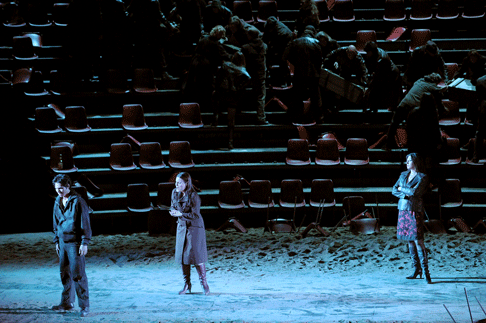 Yonghoon Lee (Don José), Genia Kühmeier (Micaëla), Nadia Krasteva (Carmen)
Yonghoon Lee (Don José), Genia Kühmeier (Micaëla), Nadia Krasteva (Carmen)
I am not sure what eluded me about Genia Kühmeier’s perfectly well-sung Micaela, but there seemed to be a warmth missing from her stage presence, and well, the character is the one that should be nothing but sympathetic. Perhaps it was her rather pristine Mozartean tone and delivery? I have seen this role steal the show entirely, and if she didn’t quite manage that, in fairness, the audience gave her polished performance an enthusiastic ovation.
Kyle Ketelsen made every minute of his stage time count with his swaggering, cock-sure traversal of Escamillo. Mr. Ketelsen is one of those performers who has star presence to spare, and happily he has a resonant, highly-responsive bass instrument that can carry out his intentions very impressively indeed. An imaginative actor, he brings insight and variety to even such a well-known set piece as the “Toreador Song.” It is small wonder that his highly-charged persona turns our mezzo from her troubled soldier boy.
Robert Accurso (Dancairo), Marcel Reijans (Remendado), Renate Arends (Frasquita), and Nora Sourouzian (Mercédès) entertained us mightly in a breathless quintet. While all four contributed solid work throughout, Ms. Sourouzian was especially noteworthy. Nicolas Testé’s pleasing baritone made a fine impression as Zuniga.
Conductor Marc Albrecht led the familiar score with obvious affection, attention to detail, and propulsive fire. It was a true luxury to have an orchestra of the Concertgebouw’s caliber in the pit and they played with sensitivity and commitment.
One US company promoted their Carmen with the hype: “Number One on the Opera Hit Parade.” Yes, it is indeed familiar. Overly familiar? Who can say? But on the premise of familiarity breeding contempt, some producers seek to re-interpret it, or to fit it into a concept, rather than fitting the concept into it.
I have long admired stage director Robert Carsen, who is responsible for several of the very best opera productions I have ever seen. I also find him incapable of doing something that is uninteresting. And “interesting” this show is. As the audience enters the Muziektheater to take their seats, so does the “audience” on stage (aka the chorus members) who assemble randomly in semi-circular, tiered seating upstage, the whole of which embraces a sand-covered bull ring front and center. So far so good.
When the Prelude plays, first the male spectators come down to fill the ring and assume mock macho poses (think SNL’s “We’re gonna pump you up”). Then the female chorus joins them and they get all “sexy.” Oops. So far so bad. Suffice it to say that Act One does not ever substantially improve on this amateurish posturing.
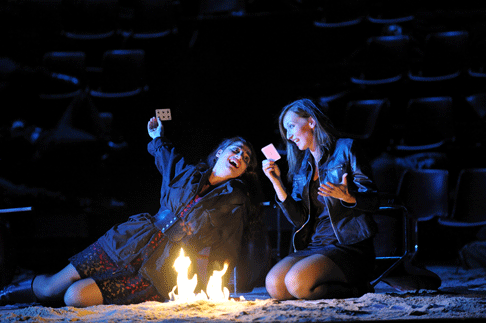 Nora Sourouzian (Mercédès), Renate Arends (Frasquita)
Nora Sourouzian (Mercédès), Renate Arends (Frasquita)
The soldiers sort of come off as soldiers, but the tobacco workers never do. There is nothing to suggest Seville’s architecture or visually underscore the plot points. There is really not much color at all save the grab-bag of Falk Bauer’s variable costumes. Worse, the performers are directed to tromp up, over, and about these chairs like singing mountain goats. If there was a dramatic motivation for marching down rows of chairs, upending them, sitting in them, or hanging around on the fringes of them, it was lost on me.
This rather dispiriting beginning propelled me to the wine bar at intermission, and perhaps the Merlot had exceptional powers because, well, damn if the rest of the evening didn’t work (and not just “after a fashion”). The stadium (Michael Levine, set design) was still there in the background but a single long row of fluorescent lights was flown in that created a suitably defined playing space for the inn. Indeed, the lighting (design by Carsen and Peter van Praet) that had been blunt and competent in One, began to play a more important role in creating atmosphere and isolating dramatic beats.
The back-lighting of Act Three’s mountain pass (that stadium again with seats scattered and irregular) was downright dramatically galvanizing. By the time we came back to the bull ring in Four, with its every seat now filled by hundreds of extras, it was like we were at whole different quality show. I worried that the final Jose-Carmen encounter might not play in the “ring” but it positively crackled, with the two of them alone in the light and the rest in blackness. And when the chorus suddenly rose in blazing down-light to sing their first interjection, the moment was chills-inducing.
Perhaps all of this would not have worked so well had it not been set up by the foolishness and vagaries of Act One. Perhaps. But to all directors of “familiar” works I say: there is always someone in the audience to whom the work is new. Always. Without having read the synopsis, could a neophyte have begun to understand the first act of this Carmen?
James Sohre
image=http://www.operatoday.com/carmen_155.gif image_description=Yonghoon Lee (Don José), Nadia Krasteva (Carmen) [Photo by Monika Rittershaus courtesy of De Nederlandse Opera] product=yes product_title=Georges Bizet: Carmen product_by=Don José: Yonghoon Lee; Escamillo: Kyle Ketelsen; Le Dancaïre: Roberto Accurso; Le Remendado: Marcel Reijans; Zuniga: Nicolas Testé; Moralès: Igor Gnidii; Carmen: Nadia Krasteva; Micaëla: Genia Kühmeier; Frasquita: Renate Arends: Mercédès: Nora Sourouzian. Musical Direction: Marc Albrecht. Director: Robert Carsen. Set Design: Michael Levine. product_id=Above: Yonghoon Lee (Don José), Nadia Krasteva (Carmen)All photos by Monika Rittershaus courtesy of De Nederlandse Opera
July 16, 2009
Letter from Munich: Trouble in Tahiti
[La Scena Musicale]
This rare Bernstein piece has always been problematic in the theatre. Its short 50-minute length means it isn’t quite sufficient for an evening’s entertainment.
July 15, 2009
Magic Flutes & Enchanted Forests: The Supernatural in Eighteenth-Century Musical Theater
Buch has written a number of articles for scholarly journals which provide an opposing point of view to those who consider Mozart’s magical opera to be a symbolic roadmap to Masonic nirvana. Buch’s latest opus, however, is a much more ambitious study, focusing not so much on Mozart’s Zauberoper as on its seventeenth- and eighteenth-century forerunners in France, Italy, and Germany. Magic Flutes & Enchanted Forests provides the reader with a detailed description of how the supernatural (or ‘marvelous’) was depicted in eighteenth-century operas, comedies, pantomimes, farces, ballets, and other theatrical works, and provides extensive analysis of the various literary sources for these productions.
Buch strives in his monograph to refute what he feels are the most common false assumptions about eighteenth-century opera, effectively arguing against those who have maintained that works with magical themes or sections are inherently less important than serious compositions. He also attacks the thesis that the ‘enlightenment’ was not exclusively a period of order and symmetry, and that there was ample room in the aesthetic of the day for the marvelous and fantastic. His most valuable contribution, however, is undoubtedly the detailed and comprehensive discussion of the origins of the fantastic in eighteenth-century operas and stage works. Buch successfully outlines the astonishingly wide range of material used by librettists, including fairy tales, folk legends, and obligatory references to the underworld from classical models, which provided the inspiration for so many memorable scenes or entire compositions.
The book is organized into a chronological discussion which also takes into account the important differences in European national tastes and traditions. After a brief introduction which outlines the history of the ‘marvelous’ before 1700, Buch provides two chapters on French traditions, two chapters on Italian traditions (depictions of the marvelous in opera seria and comic opera), and a chapter on Germanic musical theatre before Mozart. The final chapter is devoted to the supernatural in the operas of Mozart. The author is in his element in these discussions, and offers important insights into the fantastic elements of Mitridate, rè di Ponto, and Lucio Silla (both of which contain ombra scenes), as well as Thamos, König in Ägypten and Idomeneo. Buch’s discussion of Don Giovanni, particularly the infernal scene, contains excellent background material on the origins of the story of Don Juan. The author also focuses on Da Ponte’s effort to highlight the moralizing aspects of the story rather than follow the tone of Bertati’s Giovanni Tenorio, o sia Il convitato di pietra. Buch’s presentation of Die Zauberflöte will be of interest to any lover of opera. The origins of Schikaneder’s libretto are explored in detail, including his indebtedness to C. M. Wieland and other authors represented in the Dschinnistan collection (i.e., F. H. von Einsiedel and A. J. Liebeskind). In the course of this discussion Buch provides an analysis of the popular fairy-tale motifs of the day, and makes his most powerful arguments against a Masonic interpretation of the work. Buch shows clearly that most of the fantastic elements of Die Zauberflöte can be found in the stories of the Dschinnistan, and that attempts to explain the work by referencing complex Masonic symbolism (as was done by Paul Nettl and, more recently, Julian Rushton in the New Grove Dictionary of Opera) are misguided.
In a brief conclusion Buch’s theorizes that the fascination with supernatural, as seen in the theatrical works of Gluck and Mozart, led to a new approach to instrumental music. Buch sees the influence of the supernatural in Mozart’s two piano concertos in minor keys (K. 466 and K. 491, both composed in close proximity to Don Giovanni) and in the Requiem. The author closes by pointing out that “without this legacy of marvelous, supernatural, and terrifying topics, Beethoven might not have developed his own powerful expression in instrumental music (…) neither would Carl Maria von Weber or Richard Wagner have had as rich a musical vocabulary upon which to draw when creating their operas.”
This monograph also contains four color plates, five black-and-white figures, an excellent index, and a detailed bibliography of primary and secondary sources. Along with this there are five appendices: a chronological list of operas and stageworks with supernatural content, a list of operas based on the stories of Circe, Medea, or Orpheus, a list of operas based on the works of Ariosto and Tasso, a list of settings of the Don Juan story, and a chronological list of German theatrical works with supernatural content.
Donald R. Boomgaarden, Ph.D.
Dean, College of Music and Fine Arts
Loyola University New Orleans
ISBN-10: 0-226-07809-4 price=$39.84 product_url=http://astore.amazon.com/operatoday-20/detail/0226078094
The Met's Favorite Tenor: Marcello Giordani
Chatting over coffee last week I found him refreshingly unegotistical about his status, and full of praise for his colleagues in London and for the production of Tosca - ‘It was really something special last night (the first night) with such a stellar cast, and even though the staging is traditional it is still very dramatic, very respectful of the music and the singers - quite a rare thing nowadays, when directors feel they have to be revolutionary and impose their own ideas, but this one respects the composer above all. What really interested me here was the way the acting was managed - everything makes sense with the movement, and I felt that the audience really responded to that. They were so involved with the intensity of the drama that the applause after the arias was much more muted than usual - but they gave us fantastic ovations at the end!’
Marcello was especially taken with Bryn Terfel’s Scarpia - ‘Wow! The scariest I have worked with - I was quite terrified myself, which is funny when you recall that he is such a really nice guy, and almost because of that, his performance is remarkable.’ The production is unusual this time around in that it features two sopranos sharing the title role, something which appeared to faze him not at all - ‘I know them both well, I have worked with Angela (Gheorghiu) many times and have known Nelly (Miricioiu) for fifteen years; I know that audiences imagine that singers sometimes walk onto a set and meet their colleagues for the first time, but even if it were really like that - and it is not - we are professionals, and we know how to respond to each other. In cases like this, it really all comes down to the production, and it’s a testament to its excellence that we were all able to adjust so quickly.’
Given his pre-eminence in the US and elsewhere, it’s surprising that Giordani rarely sings in London - he made a sensational UK debut under Solti in 1995, in the ROH La traviata. He will perform the role of Adorno (Simon Boccanegra) at the Met in 2010, when Plácido Domingo will take the title role, as he will in London, but when it comes to Covent Garden, Adorno will be sung by Joseph Calleja. Marcello loves London, appreciating especially the enthusiasm which audiences have for music here, so he is glad to be coming back when the Tosca is revived in 2011.
For me, his singing is exceptional in that it is not the really belting parts which typify it, but the more tender moments - ‘Yes, you are right, ‘O dolci mani’ is indeed very difficult because it follows much more torrid music, and then you have to scale the voice down to something far more intimate.’ It’s not that there’s anything wrong with the can belto Italian tenor, but ‘You are paying me a big compliment when you say that my singing is more in the bel canto style, and I accept that! Most of my career was spent with bel canto, so my approach is different, but back then that music was not so popular - now, we have a revival with Flórez and other singers, so my approach is coming back, and I am flattered when people who know a lot about singing tell me that my approach is ‘old-fashioned!’
Directly after Tosca he will go to Madrid for a concert commemorating Puccini’s 150th anniversary, and then to Torre del Lago and Verona - ‘I have a special feeling for Torre del Lago; Puccini called it ‘a paradise’ and you can really feel the spirit of the composer there all around you - the new opera house there means that we are not camping in fields anymore, but the intimate quality is still there!’ He will then sing in the Met’s Turandot - ‘Calaf is not my favourite role, I prefer the passion and tenderness of the more romantic parts, and of course the audience is always waiting for ‘Nessun Dorma.’
Pinkerton might seem to be another role like Calaf, which he likes to sing but does not especially empathize with, yet the Anthony Minghella production of Madama Butterfly remains one of the best experiences of his operatic life - ‘I found Anthony very humble, very knowledgeable about opera, very respectful of the voice; I learned so much from him, in fact he changed my perceptions of opera forever. He taught me a lot about staging - I used to think that because a stage was huge you had to make huge movements, but he showed me how to think in terms of intimate stage pictures - a case of a background in the movies really making a difference in opera, which of course is not always the case!’
Marcello famously stepped in to sing in Faust at the Met on the same day as he performed as Pinkerton - but for him, it was not really a case of showing that he is, as Peter Gelb said, ‘the iron man of tenors’ - ‘For me, the Met is like home, like family, and so when someone in the family has a problem, one just helps out, that’s all.’ This collaborative approach extends to sponsoring Master classes both in New York and in his home town in Sicily, although he is not complimentary about the Italian attitude to home-grown talent - ‘In Paris, Alagna is like a God, so is Flórez in Peru, and they deserve it - but for Italy, one really has to go abroad to reach such appreciative heights!’
His repertoire is a wide one, taking in many of the great French roles, with a special love for Berlioz and Meyerbeer - he declares that he wants to be regarded not just as an Italian tenor, but as a complete artist, and indeed his musical tastes are exceptionally wide-ranging - he surprised me by saying that he has two great dreams to fulfil in musical terms, the first one being to sing Mahler: ‘For me, this is the most innovative music, especially das Lied von der Erde, and I long to sing it.’ His second dream is to sing Lohengrin, ‘Maybe one day in the future, since it is quite possible for my voice, it is more Italian than, say, Tristan, and Wagner wrote it in Italy, too!’
Unlike Domingo, he does not think of branching out into Handel, nor does he see himself as an Otello just yet - ‘I have too much respect for that role, and for the great tradition of those who have sung it; my voice is not ready, for me there is more study before I can take that on, and want to be worthy of my predecessors such as Mario del Monaco. There is still much for me to do in the core repertoire, and of course I am hoping to sing Hoffman again, as that is one of those parts which all tenors dream of.’
He says that for him, just being onstage is the best part of his career - ‘It’s much better than working! You have to be a bit of a clown, or a bit crazy, or a bit larger than life, or maybe a bit insane to be a singer!’ Perhaps, but above all it is musicianship which defines this tenor, whose singing the present writer has described not only as ‘powerful’ but ‘tender (and) finely phrased.’
Melanie Eskenazi
image=http://www.operatoday.com/MarcelloGiordani.gif imagedescription=Marcello Giordani [Photo by Dario Acosta]
product=yes producttitle=The Met’s Favorite Tenor: Marcello Giordani productby=Interview by Melanie Eskenazi product_id=Above: Marcello Giordani [Photo by Dario Acosta]
July 14, 2009
Il Barbiere di Siviglia at Covent Garden
With the characters afflicted by ‘anvil-hammer headaches’, scarlet fever and debilitating foot cramps, we were reminded that Bartolo is in fact an ‘esteemed’ doctor and that Figaro lists ‘surgeon’ as one of his skills. Indeed, it seemed that Bartolo was right when he complained that Figaro was turning ‘this house into a hospital’ — not least because the prima donna, Rosina, was wheelchair-bound throughout.
This was not, however, a quirky directorial whim of the kind that 21st-century audiences have become all too familiar with. There cannot be many Rosinas who would willingly elect to tackle the substantial challenges of the role from this confining position, but there was little choice for the American mezzo-soprano, Joyce DiDonato who, having continued valiantly after slipping on the opening night, subsequently discovered that she had in fact fractured her fibia. Forbidden to put any weight on her plaster-encased leg, DiDonato must have been in considerable discomfort, if not pain, and the audience whole-heartedly appreciated her determination to continue in the role, welcoming her first stage entry with a rapturous outburst of grateful applause.
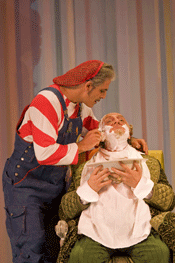 Pietro Spagnoli as Figaro and Alessandro Corbelli as Doctor Bartolo
Pietro Spagnoli as Figaro and Alessandro Corbelli as Doctor Bartolo
If she was physically incapacitated, DiDonato was in no way vocally,
musically or dramatically hampered. This was an outstanding - and given the
circumstances, astonishing — performance. Capricious and independent
throughout, she overcame the physical restrictions imposed on her, offering a
consummate display of coloratura singing and acting with panache and verve.
DiDonata’s technical mastery is accompanied by innate musicality and
powers of communication: she manages to make Rossini’s idiosyncratic
twists, leaps, stutters and dynamic dips sound both effortless — in
‘Dunque io son’ she dazzled with a thrilling sparkle of a trill
— and genuine.
Paradoxically, she used her injury to superb dramatic effect. Trapped both figuratively and literally, DiDonato presented a poignant picture of innocent vulnerability, threatened by a domineering tyrant; but simultaneously she twisted, pouted, whizzed from left to right, swung her undamaged legs and flailed her arms, allowing the petulance and feistiness of the ‘real’ Rosina to shine through.
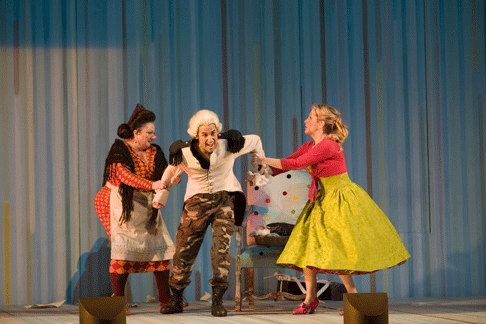 Jennifer Rhys-Davies as Berta, Juan Diego Flórez as Count Almaviva and Joyce Didonato as Rosina
Jennifer Rhys-Davies as Berta, Juan Diego Flórez as Count Almaviva and Joyce Didonato as Rosina
DiDonato was partnered by a fine cast of principals. From the moment he leapt onto the stage with a knowing nod and grin, after striding masterfully through the surprised audience, Pietro Spagnoli’s Figaro held the attention of all. This was a Figaro of enterprise, boundless energy and optimism, and the sprightliness of Spagnoli’s stage presence was matched by the vigour and meatiness of his singing. He relished the tongue-twisting patter and demonstrated a rich, deep warmth when offering a supporting shoulder to the pair of thwarted lovers. Standing in for Simon Keenlyside, this was Spagnoli’s Covent Garden debut — and on this evidence he should be back soon.
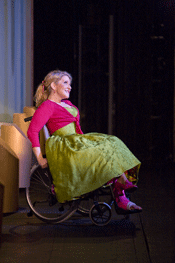 Joyce DiDonato as Rosina [Photo by Neil Gillespie courtesy of The Royal Opera House]
Joyce DiDonato as Rosina [Photo by Neil Gillespie courtesy of The Royal Opera House]
One pities Colin Lee, sharing the role of Count Almaviva with no less a
stellar light than Juan Diego Flórez, whose effortless dispatch of the fiendish
coloratura in the closing scene nearly brought the house to a
standstill on the opening night of the run. Understandably perhaps, Lee seemed
nervous at the start, as he strove to over-colour the words in his opening
‘Ecco ridente’, worthily emphasising the pain of unrequited love
but producing an ugly, strained timbre in the process. Fortunately he became
progressively more relaxed, and a legato tenderness and more subtlety
of tone characterised his performance subsequently. More comfortable with his
disguise as the spineless music teacher, Alonso, than as the drunken soldier
who blunders his way into Bartolo’s house, in Act 2 Lee settled into the
role, and in ‘Cessa di piu resistere’ he demonstrated a beautiful
tenore di grazia, lightly presenting the vocal flourishes and singing
with a joyful delicacy at the top of his register, with no sense of strain.
He was often criticised for creating emotionless characters, and it is true that many of Rossini’s principal roles here are simply caricatures. Nevertheless, Alessandro Corbelli warmed up nicely as the egotistical, domineering Dr Bartolo, producing some wonderful comic timing. His acting prowess was matched by Feruccio Furlanetto, as the unctuous, despicable Basilio. Furlanetto’s massive bass resonated with menace and evil intent. Indeed, in his calumny aria, he so revelled in the salacious, almost hysterical, delight he gained from his plans to slander Almaviva, that he came a little adrift from Pappano’s tempo, in one of the rare moments of shaky ensemble between stage and pit.
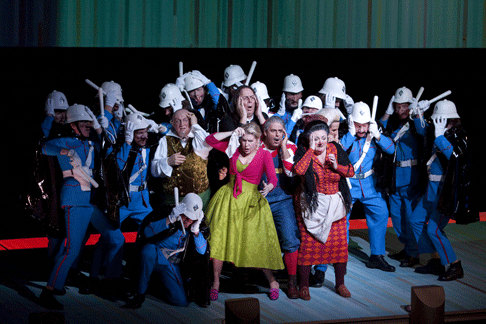 Alessandro Corbelli as Doctor Bartolo, Joyce Didonato as Rosina, Pietro Spagnoli as Figaro, Jennifer Rhys-Davies as Berta, (Back Row) Ferruccio Furlanetto as Don Basilio, and The Royal Opera Chorus as Police
Alessandro Corbelli as Doctor Bartolo, Joyce Didonato as Rosina, Pietro Spagnoli as Figaro, Jennifer Rhys-Davies as Berta, (Back Row) Ferruccio Furlanetto as Don Basilio, and The Royal Opera Chorus as Police
The smaller roles were also strongly cast. Jennifer Rhys-Davies presented a well-conceived Berta, singing with a verve and confidence which were equalled by Korean baritone, Changhan Lim, a Jette Young Artist, who showed much promise as Fiorello.
It was a minor flaw of this starry production that occasionally the zany design of this revival of Moshe Leiser and Patrice Caurier’s wacky 2005 staging (with slight adaptations to accommodate DiDonato’s new mode of locomotion) threatened to upstage the singing. Leiser and Caurier’s long-term collaborators, Christian Fenouillat and Agostino Cavalca did not fail to exaggerate every comic moment. The pastel-box set with its web of sliding panels, trap doors and concealed windows certainly conveyed Rosina’s entrapment, but the garish, postmodern lines and dots and pantomimesque costumes — the nadir was reached when the police arrived sporting white, plastic helmets and black PVC capes — were cheap and nasty. The closing picture of red, heart-shaped balloons floating aloft was pure Eurotrash.
This is an undoubtedly funny production, but the directors over-play Rossini’s subtle side-swipes at theatricality and operatic conventions. In particular, the end of Act 1 was distinctly bewildering: the stage tilted and rocked from side to side, escape routes disappeared, as the ‘dazed and confused’ cast clutched their heads in uniform agony. Even Pappano, elsewhere so sure and in command at the podium or harpsichord, struggled to maintain the dramatic and musical momentum as the entire cast wobbled and staggered like a ship in danger of sinking.
Fortunately Antonio Pappano ensured that Rossini’s music retained prime position. From the crisp rhythms and tight runs of the overture, it was clear that the ROH band were once again on sparkling form. Pappano coaxed fresh colours from this well-known score and reinvigorated familiar rhythms with spontaneity. This operatic ‘old friend’ can certainly still astonish and impress.
Claire Seymour
image=http://www.operatoday.com/BC200907010061.gif image_description=Joyce DiDonato as Rosina [Photo by Bill Cooper courtesy of The Royal Opera House] product=yes product_title=Gioachino Rossini: Il Barbiere di Siviglia product_by=Figaro: Pietro Spagnoli; Rosina: Joyce DiDonato; Count Almaviva: Juan Diego Flórez / Colin Lee; Doctor Bartolo: Alessandro Corbelli; Don Basilio: Ferruccio Furlanetto; Fiorello: Changhan Lim; Berta: Jennifer Rhys-Davies. Conductor:Paul Wynne Griffiths / Antonio Pappano. Director: Patrice Caurier / Moshe Leiser. Set Designs: Christian Fenouillat. Costume Designs: Agostino Cavalca. Lighting: Christophe Forey. product_id=Above: Joyce DiDonato as RosinaExcept as indicated, all photos by Bill Cooper courtesy of The Royal Opera House
July 13, 2009
Korn/Ferry Sponsorship Pullout Shakes Holland Park: Interview
Interview by Warwick Thompson [Bloomberg, 14 July 2009]
July 14 (Bloomberg) — When the heroine coughs her last note at the end of Puccini’s “La Boheme,” the sobbing tenor flings himself over her body and wails.
Down on a Virginia Farm, a New Festival of Music
By Steve Smith [NY Times, 14 July 2009]
CASTLETON, Va. — After Lorin Maazel conducted his last concerts as New York Philharmonic music director with four performances of Mahler’s grandiose “Symphony of a Thousand” in late June, you could hardly fault him for seeking escape at his country home. Mr. Maazel, 79, however, has an idea of retreat that is different from most people’s: awaiting him at his 550-acre Virginia estate, Castleton Farms, were some 200 young singers, instrumentalists, conductors and theatrical designers, assembled for the first Castleton Festival.
SF Opera celebrates beginning new era with incoming music director Nicola Luisotti
By Cindy Warner [SF Examiner, 13 July 2009]
SAN FRANCISCO (July 10, 2009)--Ushering in a new era for San Francisco Opera, Nicola Luisotti begins his inaugural year as music director on Friday, September 11 at the historic War Memorial Opera House with Giuseppe Verdi’s Il Trovatore, featuring an all-star cast that includes Sondra Radvanovsky, Stephanie Blythe, Marco Berti, and Dmitri Hvorostovky.
The Diva Has Issues
By Anthony Tommasini [NY Times, 13 July 2009]
MANCHESTER, England — Before the premiere of Rufus Wainwright’s first opera, “Prima Donna,” as part of the Manchester International Festival at the Palace Theater on Friday evening, Mr. Wainwright dropped hints that he would show up costumed as a famous operatic figure. Sure enough, while a crowd milled in the lobby before the performance, Mr. Wainwright arrived meticulously made up as Verdi, in a formal 19th-century black suit, complete with white silk scarf, black top hat and a bushy beard grown for the occasion.
July 12, 2009
GOUNOD: Faust — 1953
Music composed by Charles Gounod. Libretto by Jules Barbier and Michel Carré after Faust by Johann Wolfgang von Goethe
First performance: 19 March 1859 at Théatre-Lyrique, Paris
| Principal characters: | |
| Marguerite | Soprano |
| Faust | Tenor |
| Méphistophélès | Bass |
| Valentin | Baritone |
| Wagner | Baritone |
| Siébel | Soprano |
| Marthe | Soprano |
Synopsis:
Act I
Faust’s cabinet.
The philosopher Faust is profoundly depressed by his inaptitude to reach fulfillment through knowledge and thinks of committing suicide. He pours the contents of a poison phial in a cup, but stops suddenly drinking the deadly liquid when he hears a pastoral choir. He damns happiness, science and faith and calls on Satan to guide him. Méphistophélès appears (duet: “Me voici”). Faust confesses to him that he looks for youth, more than wealth, glory and power. Méphistophélès agrees to fulfill the wishes of the philosopher, in exchange for his services in the infernal regions. As Faust hesitates to accept this condition, Méphistophélès has Marguerite appear to him sitting at her spinning wheel. Faust signs then the document and is transformed into a noble young person.
Act II
The carnival at the city gates. One sees a cabaret on the left.
The curtain rises on a joyful choir of students, soldiers, bourgeois, girls and stout women (choir: “Vin ou Bière”). Valentin enters, holdin in his hand a medal which his sister Marguerite gave to him; he is about to leave for war, and is giving instructions to his friends, notably to Wagner and Siébel, so that they take care of her. They sit down to take a last glass.
Méphistophélès appears suddenly, and amuses them with a song on the golden veal (round dance: “Le veau d’or”). Valentin gets angry when Méphistophélès talks lightly about his sister, but his sword breaks in the air before reaching its target. Confronted with a supernatural power, Valentin and his companions brandish crossshaped knobs of their swords in front of the devil (choir: “De l’enfer”). Méphistophélès remains alone, soon joined by Faust and by a group of village waltzers (waltz and choir: “Ainsi que la brise légère”). When Marguerite appears among them, Faust offers her his arm; she refuses with modesty and goes away deftly.
Act III
Marguerite’s garden.
Siébel is in love with Marguerite and sets down a bouquet for her (stanzae: “Faites-lui mes aveux”). Faust and Méphistophélès enter the garden; while the devil is in charge of finding a present for Marguerite, Faust shouts out to Marguerite’s house and to the defending embrace of nature (cavatina: “Salut, demeure chaste et pure”). Méphistophélès returns and sets down a casket with jewels for the girl.
Marguerite arrives, wondering who was the young gentleman who approached her earlier. She sings a ballad on the king of Thulé, discovers the bouquet and the casket of jewels and, quite incited, tries earrings and necklace (scene and air: “Il était un roi de Thulé”). Marthe, Marguerite’s governess, tells her that these jewels have to be the present of an admirer. Méphistophélès and Faust join the two women; the first tries to seduce Marthe, while Faust converses with Marguerite, who shows herself still very reserved (quartet: “Prenez mon bras”).
While Faust and Marguerite disappear for a moment, Méphistophélès casts a fate to the flowers of the garden. Marguerite and Faust return and she allows Faust to kiss her (duet: “Laisse-moi, laisse-moi, contempler ton visage"); however, she steps back suddenly and asks him to go away.
Convinced of the insignificance of his efforts, Faust is resolved to abandon his project altogether. He is stopped by Méphistophélès, who orders him to listen to Marguerite at her window. When hearing that she hopes for his quick return, Faust shows himself and takes her hand; as she drops her head on Faust’s shoulder, Méphistophélès cannot refrain from laughing.
Act IV
Marguerite’s room.
Marguerite has given birth to Faust’s child and is ostracised by girls in the street. Saddened because Faust abandoned her, she sits down at her spinning wheel (air: “Il ne revient pas”). Siébel, always faithful, try to encourage her.
A square.
The return of Valentin is announced with soldiers’ walking, and it becomes clear that things are going to deteriorate. Having heard Siébel’s evasive answers to the questions he asked about his sister, Valentin rushes furiously in the house. While he is inside, Méphistophélès satirically plays the role of lover, giving a serenade under Marguerite’s window (serenade: “Vous qui êtes l’endormie”). Valentin reappears and demands who took his sister’s innocence. Faust pulls his sword; during the ensuing duel, Valentin is lethally wounded. As he dies, he throws back all responsibility on Marguerite and damns her for the eternity.
A cathedral.
Marguerite tries to pray, but is prevented from it by,first, the voice of Méphistophélès, then by a devils’ choir. She finally succeeds in finishing her prayer, but faints when Méphistophélès releases a last curse.
Act V
The mountains of the Harz. The night of Walpurgis.
One hears a choir of will o’ the wisps when Méphistophélès and Faust appear. They are quickly surrounded by witches (choir:”Un, deux et trois”). Faust tries to run away, but Méphistophélès hurries to take him somewhere else. A decorated, populated cave of queens and courtesans of the Antiquity. In the middle of luxurious banquet, Faust sees Marguerite’s image and demands for her. While Méphistophélès and Faust leave, the mountain closes and the witches return.
The inside of a prison.
Marguerite is imprisoned for killing her child, but, thanks to Méphistophélès’s help, Faust obtains the keys of her cell. Marguerite wakes to the sound of Faust’s voice; they sing a duet of love (duet: “Oui, c’est toi que j’aime”) and Faust asks her to run away with him. Méphistophélès appears and begs Faust and Marguerite to follow him. Marguerite resists and calls for divine protection. Desperate, Faust watches and falls to his knees in prayer, while Marguerite’s soul rises towards heaven (highlight: “Christ est ressuscité”).
[Synopsis source: Charles Gounod — His life, his works.]
Click here for the complete libretto.
image=http://www.operatoday.com/Faust_Scene.gif image_description=A scene from Faust audio=yes first_audio_name=Charles Gounod: Faust first_audio_link=http://www.operatoday.com/Faust2.m3u product=yes product_title=Charles Gounod: Faust product_by=Faust: Nicolai Gedda; Marguerite: Victoria de los Angeles; Marthe: Solange Michel; Méphistophélès: Boris Christoff; Siébel: Martha Angelici; Valentin: Jean Borthayre; Wagner: Robert Jeantet. Orchestre du Théâtre National de l'Opéra de Paris Choeurs du Théâtre National de l'Opéra de Paris. André Cluytens, conducting. Studio recording, 1953.Tosca at Royal Opera House
The season has hardly had a dud moment, the highlight perhaps being the momentous Barbiere but this Tosca has to run that a close second, with its central trio of singers as well balanced as anyone could possibly desire, excellent orchestral sound under Jacques Lacombe and a staging which respects the opera’s traditions yet does not become mired in them.
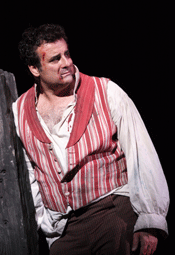 Marcello Giordani as Cavaradossi
Marcello Giordani as Cavaradossi
I have not previously warmed to Angela Gheorghiu’s singing, but this is a part which she seems to have been born to play — she’s a diva, after all, and the pseudo-coquettish shenanigans in Act I were bearable in her hands and voice where they grate from others, and the histrionics of later on were convincingly done — on this showing if poor Cavaradossi had lived, he would probably not have survived ‘il Bacio di Tosca’ for very long. She sang ‘Vissi d’arte’ with limpid tone and a kind of heartfelt beseeching of which I had not thought her capable, and her scenes with Cavaradossi, especially those describing their idyllic future, were very moving.
Marcello Giordani, a sadly infrequent guest here in London, is the Met’s tenor of choice, and it’s easy to hear why — this is a powerful, juicy, ringing voice but it is much more bel canto in style than the usual bulldog can belto in this role, and for once you could actually imagine this aristo turned Voltairean as a painter. He and Gheorgiou seemed to have a natural chemistry, the often stagy love scenes actually convincing, and he passed what to my mind is the true test of a great Cavaradossi, with a tender, finely phrased account of ‘O dolci mani.’
Bryn Terfel seems to have taken to heart the libretto’s instruction in Act III, that he should sing ‘insinuante e con intenzione’ — this was a creepy, malevolent Scarpia, one before it was easy to imagine that all Rome had trembled. I was less convinced by his desire for Tosca — the cries of ‘Ah! Tosca’ and ‘finalmente mia!’ sounding more complacent than impassioned — but his wrath was horrible to contemplate, made even more so by the characteristic retention of a beautiful, smooth legato line.
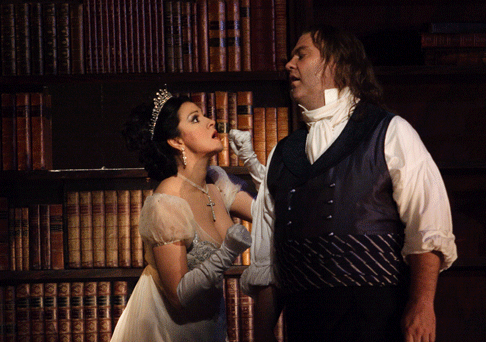 Angela Gheorghiu as Tosca and Bryn Terfel as Scarpia
Angela Gheorghiu as Tosca and Bryn Terfel as Scarpia
The smaller parts were admirably taken, Martyn Hill a finely oily Spoletta, Kostas Smoriginas a sympathetic Angelotti, and Jeremy White an avuncular, expressive Sacristan. Orchestrally we were in surprisingly commanding hands, given that the conductor was making his house debut conducting opera (he has been a stalwart of the Ballet for some time) — the lower strings especially had been coaxed into chamber music-like intimacy and the brass sparkled rather than blared.
The production is traditional in the best sense, in that Paul Brown’s designs present mostly realistic depictions of Sant’ Andrea and the Castel Sant’Angelo, the latter set against a deep blue, starry sky emblazoned with a central angel’s wing, finely suggesting both Bernini’s Angel on the bridge by the castle, and the ‘Avenging Angel’ which stands atop the building. The central influence in Scarpia’s study seems to be Cellini, the massive quality of his bronzes suiting the man’s power and ego. Mark Henderson’s lighting evocatively suggests both claustrophobic interiors and encroaching night, and Stephen Barlow’s direction of the principals follows Jonathan Kent’s naturalistic, unforced approach.
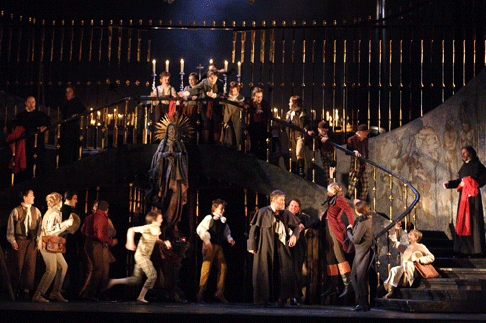 A scene from Tosca
A scene from Tosca
Like the previous Visconti staging, this Tosca will be with us for many years, but it is hard to imagine it being graced with such strong principal singers as this time around. Just four more performances, on July 11th, 14th, 16th and 18th.
Melanie Eskenazi
image=http://www.operatoday.com/GheorghiuToscaROH02.gif imagedescription=Angela Gheorghiu as Tosca [Photo by Catherine Ashmore courtesy of The Royal Opera House]
product=yes
producttitle=Giacomo Puccini: Tosca
productby=Tosca: Angela Gheorghiu; Cavaradossi: Marcello Giordani; Scarpia: Bryn Terfel; Spoletta: Martyn Hill; Angelotti: Kostas Smoriginas; Sacristan: Jeremy White; Sciarrone: Matthew Hargreaves; Gaoler: John Morrissey. The Royal Opera. Conductor: Jacques Lacombe. Director: Jonathan Kent. Designs: Paul Brown. Lighting: Mark Henderson.
product_id=Above: Angela Gheorghiu as Tosca
All photos by Catherine Ashmore courtesy of The Royal Opera House
July 11, 2009
The Royal Opera's 2008-9 season ends in a blaze of glory with Rossini's Il Barbiere di Siviglia and Puccini's Tosca
By Rupert Christiansen [Daily Telegraph, 10 July 2009]
The Royal Opera’s 2008-9 season ends in a blaze of glory with a superb revival. Rossini’s Il Barbiere di Siviglia will never feature in a list of my thousand favourite operas, but in a performance as delicious as this was, even I couldn’t resist its charms.
July 10, 2009
Bright lights among the shades — The passion of Orpheus pervades a historic Aldeburgh Festival
Guy Dammann [The Times Literary Supplement, 10 July 2009]
Composers will keep revisiting the story of Orpheus: it demands operatic treatment if it is to be told properly. One must also bear in mind the rather flattering testimony the story pays to the composer’s art. By the time Gluck and Calzabigi composed what remains one of the best known operas on the subject in 1762, the number of operatic treatments stood at fifteen - and that figure not including numerous dramatic cantatas by, among others, Charpentier and Rameau. Many of the first experiments in musical theatre concerned themselves with Orpheus, although in 1600 both Jacopo Peri and Giulio Caccini titled their proto-operas Euridice, focusing less on the powers of the Thracian bard than on the figure whose loss inspired him to retune his lyre to immortal ears.
July 9, 2009
Mortier Leaves Paris With an Ending That’s a Beginning
By Steven Erlanger [NY Times, 9 July 2009]
PARIS — Much of the world may have been watching the obsequies for Michael Jackson, which were also shown live on French television, but a different kind of artistic farewell also took place here on Tuesday night: the premiere of a theatrical work by the German painter Anselm Kiefer, the last commission of Gerard Mortier’s tenure as director of the Paris Opera.
Soprano Upshaw muse to composer
By Janelle Gelfand [Cincinnati Enquirer, 9 July 2009]
Before opera star Dawn Upshaw became known for her million-selling recording of Gorecki’s Symphony No. 3, her Mozart roles at the Metropolitan Opera and her work with composers such as John Adams, Kaija Saariaho and Osvaldo Golijov - she was thinking of singing on Broadway.
DONIZETTI: Don Gregorio
After Lucia di Lammermoor, in fact, it is mostly his comic operas that retain their appeal — L’elisir d’amore, Don Pasquale, and La Fille du Regiment. But this does not mean that the lesser known operas consist of foul balls and strike outs. The Dynamic label is one company that has revived many a worthy rare opera, and this DVD of a 2007 performance of the little-known Don Gregorio at the Teatro Donizetti (appropriately enough) in Bergamo may not be a home run, but it’s a solid hit.
Conductor Stefano Montanari dances his way through the overture, a Rossini-inspired affair that even includes a mini-crescendo section, possibly in homage to Donizetti’s great predecessor. A relatively early work (Stefano Olcese in the cogent booklet essay gives the year of the premiere as 1824), Don Gregorio never quite leaves the shadow of Rossini. Absent a classic Donizetti outpouring of memorable melody, such as ‘Una furtiva lagrima’ in L’elisir, this opera will probably never become a repertory item. Nonetheless, the music entertainingly supports an amusing turn on familiar comic themes of the time. The Marchese Antiquati wants the tutor of his two young sons to help the boys keep their “innocence.” However, both young men are much more knowledgeable about the appeal of the opposite sex than they are about any of the subjects Don Gregorio, the tutor, struggles to teach them. One son, in fact, has not only fallen in love, but married and produced a child, all in secret. Of course Don Gregorio tries to help the son keep this a secret, but in the end the Marchese learns the truth and reluctantly gives his blessing.
In a staging from the Wexford Festival, with sets and costumes by Ferdia Murphy, a twist is added — Don Gregorio is a cross-dresser in private, with more than usual affection for his charges. It’s a harmless enough ploy to keep the action fresh, and director Roberto Recchia manages that very well. None of the singers overacts obnoxiously, and Paolo Bordogna in the title role makes Don Gregorio an interesting twist on Rossini’s Figaro — a man of lower circumstance but with more wit and brains than his so-called superiors. Giorgio Trucco is Enrico, the married son, and Livio Scarpellini the more comically adolescent one, with a crush on his rather mature housemaid, Leonarda, amusingly performed by Alessandra Fratelli. Luca Ludovici, as Enrico’s secret wife, presents a strong, secure young woman, rather than a weepy ingenue. Giorgio Valerio rounds out the cast well as the doting father oddly concerned with the chastity of his sons.
The staging is modest, the singers more charming than impressive, at least as vocalists, and the opera really just an extended piffle — and yet, it’s harmless fun. And in the opera world today, fans should take their fun where it can be found. On that basis, this Don Gregorio earns a recommendation.
Chris Mullins
image=http://www.operatoday.com/Dynamic33579.gif imagedescription=Gaetano Donizetti: Don Gregorio
product=yes producttitle=Gaetano Donizetti: Don Gregorio productby=Giorgio Valerio; Giorgio Trucco; Elizaveta Martirosyan; Livio Scarpellini; Paolo Bordogna; Alessandra Fratelli; Luca Ludovici, Orchestra and Chorus of the Bergamo Musica Festival Gaetano Donizetti. Stefano Montanari, conductor. Roberto Recchia, director. Recorded live: Bergamo, Italy, November 2nd-4th, 2007. productid=Dynamic 33579 [DVD] price=$33.00 producturl=http://www.arkivmusic.com/classical/Drilldown?nameid1=3144&namerole1=1&genre=33&bcorder=19&comp_id=296360
DVOŘÁK: Král a uhlíř (The King and the Charcoal Burner)
Dating from the early part of Antonin Dvořák’s career, The King and Charcoal Burner (Král a uhlíř) was composed in 1871, the time when he was also establishing his reputation with his first symphonic works. Even with positive reviews, Dvořák rewrote The King and Charcoal Burner in 1874 and in 1887 revised that version further, with these revisions suggesting that even that late in his career he found the score worth his attention. Interest in the work continued after Dvořák’s death, when t he opera was revised posthumously by the conductor Karel Kovařovic for a new production in 1914. As indicated in the notes that accompany this CD, the version of the work in this recording is a conflation between the composer’s last revisions and the modifications found in the piano-vocal score which contains Kovařovic’s changes. Despite this complicated history, the performance is quite accessible and the music bears Dvořák’s stylistic imprint.
The basis for the opera is the story of a young Czech whose virtue and honesty win him a place in the court of the seventeenth-century Habsburg ruler Rudolf II during the reign of the Bohemia King Matyáš. The first act takes place in forest home of Matěj, the charcoal burner of the title, whose daughter Liduška loves Jenik, but is reticent about that, since her parents would prefer that she not marry another charcoal burner. A lost nobleman finds them, and all they know is his name, Matyáš and that he is a royal huntsman - he did not reveal himself as king. Matyáš seems attracted to Liduška, which arouses Jenik’s jealousy, but those emotions recede with the merrymaking Matěj pursues to entertain their guest before retiring in their cottage for the night.
At dawn Matyáš is already awake, and Liduška, who has also arisen, speaks to the noble about her love for Jenik. Matyáš promises to intercede, but when Jenik finds them, he assumes that Matyáš has other intentions and attacks the king. Matters resolve when Count Jindřich finds Matyáš, who gives Liduška some gold for her family’s efforts. Jenik understand the situation and realizes Liduška’s faithfulness. Yet he is also aware of his poor station and decides to become a soldier to improve his lot. A year later, Jenik’s established himself as a reliable soldier in the court, but he longs for Liduška. Count Jindřich lets Jenik know that the king has invited Matěj and his family to court. However, the king has decided to test Liduška and her family by setting up a fake trial against them, with Jenik informed of ruse. The king claims that Matěj used Liduška to lure him to their cottage with the intention of robbing him before having Jenik the charcoal burner murder the king. He even tells them that Jenik is imprisoned and awaiting execution. Liduška offers her own life in exchange for Jenik’s freedom, and at that point, the king explains the ruse and reveals his identity to Matěj and his family.
A summary of the plot is useful to point out the situations which would inspire Dvořák’s musical imagination. In the first act, the scenes lend themselves to a series of numbers: a chorus of huntsman, a duet between the lovers Liduška and Jenik, a chorus of coal burners, and other pieces. The end of the act also involves popular-sounding music that evokes the peasants’ merrymaking, and the religious idiom of the “Angelus” prayer at the end of the scene. In this act the music is as important as the libretto in setting up the dramatic situation. The scene between the lovers is effective through the lyricism Dvořák used to characterize them and their love, and the roles are sung well by Livia Ághová and Michal Lehotsky. Dalibor Jenis, a singer whose first name calls to mind Smetana’s opera so titled, gives an appropriate tone to the king in disguise, who functions Alidoro in Rossini’s *Cenerentola *in bringing about a satisfying conclusion to the romantic situation. In addition, Peter Mikuláš and Michelle Breedt, respectively Matěj and Anna, Liduška’s parents, command the roles well and work well in the ensembles.
In the second act, the king’s meditation after the orchestral introduction is a fine solo piece for Jenis, who delivers it convincingly, and Liduška’s soliloquy is a parallel to his, with Ághová’s restraint effective for communicating her plight. The duet that follows reflects the influence Wagner had on Dvořák, and while the thematic material is not as overtly similar as it is in the composer’s Third Symphony, the interaction of melodic motives and arioso-like passages involve Wagnerian gestures. Thus, the scene builds when Jenik, portrayed by Lehotsky, enters, and the textures intensify with the addition of chorus. Again, the use of melodic ideas to carry the text give the work a sense of music drama, rather than the kind of number-based idiom of Weber. This fine performance led by Gerd Albrecht brings out the full intensity of Dvořák’s score idiomatically, as found in the nicely paced evocation of a Czech folk tune as a kind of rondo theme in the scene with which the act ends.
As the work resolves in the third act, Dvořák continues to shape the elements into a sonic image of the court in Prague. Here Albrecht demonstrates his mastery of Dvořák’s vocal idiom and balances the sometimes full orchestral accompaniment. The mock trial of Matěj’s family is done well through the efforts of Mikuláš and Breedt, with Ághová’s Liduška’s notable for its lyrical and dramatic focus. The result is a fine performance of this little-known opera, a work which helps to give a fuller sense of Dvořák’s oeuvre. As strong a work as Rusalka is, The King and the Charcoal Burner offers insights into its composers other efforts in opera. Recorded in 2005 and now released by Orfeo, this recording makes this solid performance available with the full text in Czech, German, French and English.
James L. Zychowicz
image=http://www.operatoday.com/Orfeo048678062.gif image_description=Antonin Dvořák: Král a uhlíř (The King and the Charcoal Burner).
product=yes producttitle=Antonin Dvořák: Král a uhlíř (The King and the Charcoal Burner) productby=Dalibor Jenis; Peter Mikuláš; Michelle Breedt; Livia Ághová; Michal Lehotsky; Markus Schäfer, Prager Kammerchor; WDR Rundfunkchor Köln, WDR Sinfonieorchester Köln, Gerd Alvrecht, conductor. productid=Orfeo 678062 [2CDs] price=$41.99 producturl= http://www.arkivmusic.com/classical/Drilldown?nameid1=3313&namerole1=1&genre=33&bcorder=19&comp_id=54145
An Acrobatic Approach to a Ruminative Tale of Love
By Anthony Tommasini [NY Times, 8 July 2009]
LONDON — The struggling New York City Opera should take heart from its “people’s opera” counterpart in London, the English National Opera. Not so long ago the English National was similarly mired in an artistic, administrative and financial crisis. But under the leadership of John Berry, as artistic director, and Edward Gardner, as music director, the company has rebounded. It now draws large audiences to innovative productions at its meticulously restored home here, the old Coliseum Theater, originally a variety hall.
"American Idols" of opera, SFO's Heidi Melton and Leah Crocetto, win big bucks $75,000
By Cindy Warner [SF Examiner, 8 July 2009]
Remember when Maestro Donald Runnicles conducted the Verdi Requiem as his auf Wiedersehen to San Francisco? Headlining soprano Patricia Racette had to bow out the day before due to illness, opening the stage door for Adler Fellow Heidi Melton to step up? Heidi was fresh off of a win in New York of $10,000 and she’s won the big bucks again in Los Angeles, this time $25,000.
July 7, 2009
In Performance: Bach Festival opens
By Joan Reinthaler [Washington Post, 7 July 2009]
The “Coffee Cantata” and the “Peasant Cantata” were the closest Bach ever came to dabbling in opera. Spoofs on cultural foibles of 18th-century Germany, they are full of the upbeat gaiety that infects settings of even some of his most didactic texts.
Opera Maverick Makes Small Festival a Top Draw
By George Loomis [NY Times, 7 July 2009]
ERL, AUSTRIA — It is said that the Salzburg and Bayreuth festivals have long had an understanding that Salzburg will not do Wagner and Bayreuth will do nothing but. Yet with applicants having to wait seven years for tickets, Bayreuth hardly needs protection from competition. In fact, the annual Munich Opera Festival has always had a major Wagner component. But since 1998, another, less orthodox enterprise has also toiled on behalf of the master of the music drama, and in roughly the same neck of the Austro-Bavarian woods.
Benjamin Britten: A Time There Was. . .
A Time There Was… is refreshingly straightforward, without artifice to alter the emphasis implicit in the documentation itself. The comments of family members are touchingly revealing. Some of the details are remarkably pithy about the environment in which Britten grew up, and Palmer is good not to editorialize. Details take shape within the context of the film. For example, Britten’s cousin Elsie’s comment about the composer’s prescience might sound out of place, but Palmer’s inclusion of it underscores some of Leonard Bernstein’s remarks about Britten’s music, and touches like these are entirely characteristic of the film.
Originally released in 1979, just three years after Britten’s death, this issue on DVD makes the film available to new audiences. (A comprehensive filmography is available at www.tonypalmer.org.) More than that, the release demonstrates the strength of Palmer’s film, which holds up well after three decades. While some of the footage in A Time There Was… has a grainy look, that quality contributes to the overall feel of Palmer’s film in bringing forward firsthand materials to document his subject. In terms of the concept and sense of the whole, A Time There Was… remains a fine, convincing portrait in film. Unlike some more recent film biographies, it lacks some of the aspects of the biopic by remaining close to the subject. The narrative is implicit in the images and pacing Palmer brings to the screen. The director is present in the presentations, not as a rear of a head asking questions in interviews or contributing a narrative to hold the images together. The images lead one to the other, and the narrative is found within the careful editing of the source material.
In addition the rehearsal clips give a sense of Britten working on his music in ways that others could not convey as effectively. In addition, the judicious selection of musical examples helps to anchor the film nicely in the sonic world Britten created. Not everyone would choose the same examples, but Palmer achieved a representative variety, which not only gives those unfamiliar with Britten’s music a useful introduction, but also serves to remind those who know the repertoire to return with renewed interest. For example, Britten’s contributions to film may not be the entire basis for his reputation, but the fact that he worked in this idiom is useful information. More than that, his efforts are not without interest, especially in the clip which Palmer used from the film The Way to the Sea.
At the same time, the treatment of the relationship between Britten and Peter Pears is sensitive and balanced. It is neither condescending nor apologetic, and that is as it should be. As appropriate as it now seems, such a balanced approach seems to be remarkable for its time, and the result stands well, decades after Palmer originally released the documentary.
While a fine body of primary and secondary materials exist in print to document Britten’s life and works, this documentary brings certain aspects of his career to life in ways that film does best. To Palmer’s credit, his films on Ralph Vaughan Williams, Malcolm Arnold, Igor Stravinsky, and others have earned his praise, and the release on DVD of the present documentary about Benjamin Britten stands well with the others. A solid film when it was first issue, this newly issued DVD continues to make available an important and engaging resource on Britten.
James L. Zychowicz
image=http://www.operatoday.com/TPDVD125.gif image_description=Benjamin Britten A Time There Was…
product=yes
producttitle=Benjamin Britten A Time There Was…
A film by Tony Palmer featuring extracts from: Peter Grimes; Billy Budd; A Midsummer Night’s Dream; War Requiem; Curlew River; Death in Venice; Nocturne; Young Person’s Guide to the Orchestra.
productby=With: Benjamin Britten; Peter Pears; Leonard Bernstein; Sviatoslav Richter; Janet Baker; Julian Bream; Heather Harper; Imogen Holst; John Shirley-Quirk; Rudolf Bing; Henry Moore; English Chamber Orchestra, conducted by Steuart Bedford.
productid=TPDVD125 [DVD]
price=$26.99
producturl=http://www.amazon.com/dp/B000JGWCZG?tag=operatoday-20&camp=14573&creative=327641&linkCode=as1&creativeASIN=B000JGWCZG&adid=0A9TQ7RGT6C7Y59GVZYT&
Saariaho’s sumptuous L’amour de loin at the ENO, London
This new production at The English National Opera, created by noted circus director Daniele Finzi Pasca proves that superlative staging can make up for weak narrative. Through visual images, the spirit of L’Amour de loin is invoked to express the drama beneath the music, better than the text itself.
Kaija Saariaho’s music wavers in a langorous swoon. Cadences rise and fall away, legato rippling upwards and down without regard to syntax. This is lavishly sensual, complete with faint echoes of the French medieval world of the troubadour, Jaufré Rudel (Roderick Williams), and the “Moorish” exoticism of Tripoli where the heroine Clémence (Joan Rodgers), resides. It’s the musical equivalent of intoxicating fumes, perfume or perhaps some strange potion inhaled through a hookah. Dramatic structure isn’t relevant to mood music as dream-like as this.
Love, after all, is an “altered state” where logic doesn’t apply, particularly in the case of idealized troubadour love, where artistic indulgence is as much an impetus as the love object. No wonder Jaufré panics and becomes fatally ill when he crosses the sea to meet Clémence for the first time. Unlike Tristan und Isolde where strong characters are transformed by a potion, to the horror of those around them, everyone in L’amour de loin, even the Pilgrim, is complicit in the dream state, so intensity dissolves in romantic washes of chromatic color.
Saariaho’s writing works best describing images like the ocean crossing, one of the most brilliant scenes in this production where light images are projected onto waving expanses of silk. It’s less suited to dramatic rationale. Jaufré and The Pilgrim debate endlessly whether he’s mad but the point’s already made in the music. Narrative meaning is further obscured by the distortion of natural rhythm and by dropping single spoken words into lines that are otherwise sung. Richard Stokes’s translation is lucid but retains the unworldly illogic of the original.
Roderick Williams, Joan Rodgers and Faith Sherman sing well, but this isn’t an opera where character development matters much. Its energies lie in the non-vocal writing, giving Edward Gardner and the ENO Orchestra a chance to luxuriate in lush orchestral texture.
The last scenes, where Clémence curses God, then quite quickly gives in to His will, might afford great opportunities for drama had the libretto engaged seriously with ideas. This is where the staging proved itself completely. As Clémence rages at God, Roderick Williams as the dead Jaufré descends from the roof on a wire, his white shroud trailing to the ground. At his side are the two “spirit Jaufrés” who had been doubling him as he lay “dying”. Is it a reference to Christ flanked by the two thieves at the crucifixion ? Perhaps not, but the idea is just as sacrilegious as Clémence’s curse and vaguely logical in the same sense. But as pure theatre it’s undeniably dramatic. The stage is lit up in colors as gorgeous as the music, while the chorus shine searchlights upwards towards the ceiling. Gradually the number of searchlight beams increase until the whole auditorium is bathed in unearthly white light. Whatever the image may mean, it’s a magnificent statement.
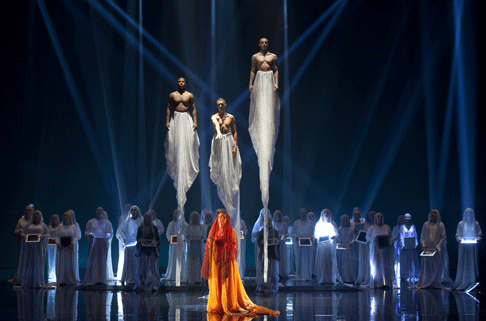 Joan Rodgers as Clémence and the spirits of Jaufré [Photo by Johan Persson courtesy of English National Opera]
Joan Rodgers as Clémence and the spirits of Jaufré [Photo by Johan Persson courtesy of English National Opera]
In an opera where ideas are so loosely defined, moments like this make all the difference. Finzi Pasca uses the specialist circus skills to extend the range of effects possible on stage. Acrobats dressed in strange headless garb “swim” in the air against a background of silk and colored lights. Huge planes of blue silk zoom onto the platform released on flywires from the upper balconies. Cutout transparencies and panels create illusions of space. Even the costumes act. Sleeves are made with huge silken extensions manipulated by actors, so it seems the singers are surrounded by huge, winged beings. It turns the opera into something truly magical.
Anne Ozorio
image=http://www.operatoday.com/LamourdeLoin012.gif image_description=Joan Rodgers as Clémence [Photo by Johan Persson courtesy of English National Opera]
product=yes producttitle=Kaija Saariaho : L’amour de loin productby=Roderick Williams (Jaufré Rudel), Joan Rodgers (Clémence), Faith Sherman (The Pilgrim), Antoine Marc, Ted Sikström, Sara Lundstedt, Lilli Mühleisen, Tamzen Moulding, Phillipa Anderson, (spirits), Robyn Simpson, Jami Read-Quarrell (shadow actors], Daniele Finzi Pasca (director, choreographer, lighting] Jean Rabasse (designs), Kevibn Pollard (costumes) Edward Gardner (conductor), Orchestra of the English National Opera product_id=Above: Joan Rodgers as Clémence [Photo by Johan Persson courtesy of English National Opera]
Coming Up Big in a Tiny Space — The Castleton Festival Stages 'Turn of the Screw'
By Anne Midgette [Washington Post, 6 July 2009]
CASTLETON, Va., July 5 — When Lorin Maazel, 79, built his home theater here, about 60 miles from Washington, he probably didn’t envision that he would be inviting quite so many people over to watch performances. A “home theater” for Maazel denotes not a private movie screen but an honest-to-goodness stage, orchestra pit and two levels of audience seating.
Dessay takes on Verdi's Violetta for 1st time
By Mike Silverman [AP, 6 July 2009]
SANTA FE, N.M. (AP) — Hey, Anna! Hey, Renee! There’s a new Violetta in town, and she’s staking a compelling claim to the role, orange wig and all.
Opera has a crush on Handel
By Kyle MacMillan [Denver Post, 5 July 2009]
Even if they have never heard of George Frideric Handel, most people are aware of the composer’s great Christmas and Easter oratorio, “Messiah,” or, at the very least, its Hallelujah Chorus.
From Ravinia to L.A., Conlon lives his rich musical life to the fullest
By John von Rhein [Chicago Tribune, 5 July 2009]
It’s nearly midnight in Spoleto, but James Conlon is still going strong. He has been busy rehearsing Woody Allen’s zany production of Puccini’s “Gianni Schicchi” practically non-stop at the Spoleto Festival of Two Worlds in this medieval town in central Italy, which is perched on an Umbrian hill clad in pine and olive trees.
July 4, 2009
The Ravenna Festival: La scuola napoletana
Now it is a lovely Adriatic seaside spot filled with remnants of the Roman and Byzantine Empires, along with fine museums, gold mosaics and many 17th century palaces. There is an elegant 19th century theatre as well as several other locations suited to musical and theatrical performances. For the last 20 years, Ravenna has had an important multi-disciplinary festival. This summer’s program (June 14-July18), includes 80 different events for an expected audience of 70,000 (approximately 25% of which are non-Italians). Its € 6 million budget is financed by a consortium of Italian central and local authorities and of private sponsors, along with box office receipts.
Riccardo Muti and his wife, Cristina, tirelessly promote the festival in part through international partnerships. In previous years, Ravenna has brought to the attention of Western European theatres jewels like the Moscow Helikon Opera and the Lithuanian National Opera. This year the main events are co-produced with the Salzburg Festival and the Paris Opéra. Other events will include the Maggio Musical Fiorentino. Internationally renowned Christoph von Dohànyi and Pierre Boulez are scheduled to conduct in addition to Muti.
This summer Maestro Muti continues to concentrate on his long-standing project concerning the “renaissance” of the La scuola napoletana (the “Neapolitan School”). In the 17th Century, Naples was not only the most populous capital in Europe but also the principal European music centre. There were important conservatories, each with a strict and disciplined course of studies. Music was on the top of the political agenda, with highly subsidized major theatres such as the San Carlo within the Royal Palace complex. Musicians (especially composers and castrati singers) were exported to all the Royal Courts of the continent with London and St. Petersburg being the most prodigious consumers. The Neapolitan Pietro Metastasio, official poet of the Vienna Court, became the most influential librettist of the age; and, through his librettos, Italian became the language spoken by the aristocracy in many a Court. [Editor’s Note: Click here for the full texts of Metastasio’s drammi per musica.]
The “Neapolitan School”, therefore, was fundamental in the development of musical theatre in general and of opera in particular. It faded away for several reasons: a) changes in tastes by a wider and no longer only aristocratic audience; b) the disappearance of the castrati (whose roles are often sung by mezzos or altos and, in certain cases, transposed for baritones); c) the high cost of stage sets and machinery.
Maestro Muti’s efforts to bring back the “Neapolitan School” have thus far succeeded. The Salzburg Whitsun Festival has been dedicated to this “School” for several years. This year he focuses his attention two composers: Giovanni Paisiello (actually born in Taranto but a leader of the School and a favorite of Russian Empress Katherine the Great) and Niccolò Jommelli (known in modern times mostly, if not solely, for his sacred music).
Jommelli’s Demofoonte had its revival in Salzburg in May of this year. It was then staged in Paris at the Opéra Garnier in mid-June. In Ravenna, it will be staged at the 800-seat Teatro Dante Alighieri on July 3-7. A European tour is planned for the fall. Demofoonte is one of Metastasio’s most popular libretti. It was set to music by 73 different composers, with Jommelli himself having composed four different versions (Muti is staging the last one). It is a “clemency tale” (e.g. like Mozart’s Titus) where the main plot simply consists of the king forgiving all his foes, albeit complicated by some five parallel sub-plots. The message is that royalty must be authoritarian because it is tolerant and forward-looking. In short, a benevolent despot is what we all need. Metastasio and Jommelli steered far away from any Revolutionary notions, lest they offend their aristocratic patrons.
Demofoonte follows all the rules and standards of the typical opera seria: vocally demanding arias, many of which are in the da capo form, along with the occasional duet and ensemble. And of course a happy ending after a series of adversities for all concerned. Cesare Lievi (stage direction), Margerita Palli (stage sets), Marina Luxardo (costumes) and, of course, Riccardo Muti conducting the Orchestra Giovanile Luigi Cherubini do their very best to attract a modern audience’s interest in this 3½-hour “clemency tale”. The cast is immaculate. Dmitri Korchack and Maria Grazia Schiavo are particularly commendable. It is easy to foresee that they have a brilliant future ahead. As for Jommelli’s Demofoonte, music schools should consider it insofar as it offers excellent training for young singers. Ultimately, it may reach some innovative opera house.
Paisiello’s Missa Defunctorum is also a rarity. Salzburg’s and Ravenna’s performances are practically the first performances in modern times (although some musicologists say that there is evidence of a performance in Florence in 1940 among the celebrations for the second centenary of the composer’s death). Paisiello is generally known as an opera buffa composer at the Courts of the Naples Kings , the Russian Empress and even Napoleon . The Missa Defunctorum was initially composed in 1789 when two children of the King of Naples died during a small pox epidemic. It was revised ten years later as a Requiem for Pius VI.
In the fall , the Missa Defunctorum will be toured by Muti and the Cherubini Orchestra in several Italian Churches and concert halls. In Ravenna, the performance took place in the Basilica of Sant’Apollinare in Classes— a site well known to Byzantine specialists for its gold and green mosaics.
Although a sacred musical work, Paisiello’s Missa Defunctorum has a strong operatic temperament. This requiem mass is quite different from those of Mozart, Verdi and others. It is a two-hour, one act opera where sorrow is mixed with hope. It is highly lyrical rather than dramatic. It is gentle, almost tender — like a late 18th century opéra larmoyant . The real drama is mostly at the end: the impressive chorale ‘Libera me’. The audience was enchanted; a good sign that Paisiello’s Missa Defunctorum may enter the repertory and may possibly be heard in Chicago where Muti is Music Director of the CSO.
Giuseppe Pennisi
image=http://www.operatoday.com/RiccardoMuti.gif imagedescription=Riccardo Muti
product=yes
producttitle=The Ravenna Festival: La scuola napoletana
productby=Click here for cast and other information relating to Niccolò Jommelli’s Demofoonte
Click here for cast and other information relating to Giovanni Paisiello’s Missa Defunctorum
July 3, 2009
Porgy and Bess in San Francisco
Maybe even some Americans were lucky enough to see the 1986 Glyndebourne production or its 1993 televised version, fabled as the best Porgy ever. Thus, with some help from its several Broadway-type attempts, the Gershwin Porgy has become a sing-along — we know every word and every note.
The San Francisco performances are a reprise of the 2005 Washington Opera production directed by Francesca Zambello, a production that has recently stopped off at the operas of Los Angeles and Chicago as well. Ms. Zambello is a noted director of large-scale opera, the Ring currently underway at the San Francisco and Washington operas, and War and Peace at the Seattle and Metropolitan operas, Billy Budd at Covent Garden as examples.
Mounting a Porgy is no small task, it has a huge cast, nine principal singers, sixteen named and solo roles that derive from an ensemble in San Francisco of forty-six [!] Black singers, not to mention three White speaking roles. Three (or more) fight scenes must be staged, plus three (or more) production numbers must be choreographed. It is scored for a full symphony orchestra that wails with the sonic abandon of big band. Can Porgy be crushed under its own weight?
The answer is an emphatic yes! Putting Porgy in the charge of a big time opera director, albeit a theatrically and operatically savvy one, magnified its weight, as did the absolute top operatic quality of its protagonists and ensemble singers (do not say chorus) placed in the hands of John DeMain, the world’s most experienced Porgy conductor. And all this thrust onto a major American opera stage where it is in de facto competition with the sophisticated operas of Benjamin Britten (maybe its closest foreign relative), not to mention the verismo of Puccini.
The end result of all this operatic know how simply lays bare the weaknesses of this Gershwin masterpiece. It does not know if it is an opera of sorts or a Broadway musical, and there is simply too much of it. Its original four hours were mercifully reduced to three hours fifteen minutes in this production, however its original two intermissions were reduced to one, making each of the two parts nearly an hour and a half. One might have preferred the longer version, but in three parts, i.e. a second pit stop. It was a long haul.
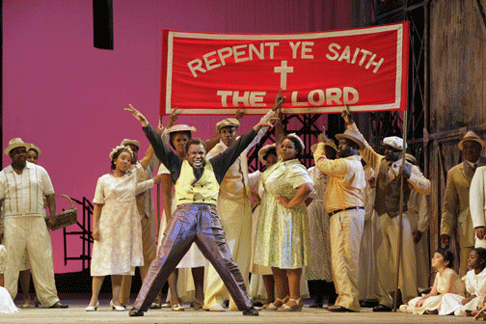 Chauncey Packer (Sportin’ Life) [Photo by Cory Weaver courtesy of San Francisco Opera]
Chauncey Packer (Sportin’ Life) [Photo by Cory Weaver courtesy of San Francisco Opera]
The decision to unify its disparate stories and elements within the confines of a single unit set was a laudable, theatrically valid solution to objectify Gershwin’s well crafted dramatic structure, but it also brought visual boredom. The intimacy needed to make small scale, essentially jazz based vocals real was lost in the vast spaces of the omnipresent two level Catfish Row with a monumental warehouse door stage left (Jake’s fishing boat was pushed in and out from here as was the interior of Porgy’s hovel). Several extraordinary moments though stand out in this generally solid staging, the Kittiwah Island departure as one example, the hurricane, and particularly the moment when Bess, high on heroin is seduced by Sportin’ Life.
Strangely moving was the sense that Gershwin’s Blacks, the 1930’s Blacks, have become not only mainstream American culture but are fully realized performers of international musical arts, led in opera by some of our greatest Porgy interpreters, like Willard White (the Glyndebourne Porgy) and a host of others. The cast for the San Francisco production gave convincing if not definitive performances, led by the Porgy of baritone Eric Owens who bestowed elegant phrasing onto Gershwin’s lines. Laquita Mitchell gave a moving and real performance, vocally and physically, as Bess. Once past mourning Sammy Davis, Jr., Chauncey Packer delivered the goods as Sportin’ Life. We wanted more physical and sexual charisma from the Crown played by Lester Lynch, and in general more distinct personalities from the other principal singers as well.
The underpinnings of Porgy are humble. It is an intimate, uncomplicated story of love and lust in an ambience of poverty well known to operatic verismo, though in Porgy there are no issues, no complaint of injustice, no philosophic formulation of fate, and finally only desperate hope. It can be and is everyone’s story at distinct moments in human history. The challenge is to create an atmosphere for this humility in what is, pure and simple, an extravagant art form, and it was here that this production failed.
The copyright for this American operatic masterpiece (who cares if it has short comings, and is not really stage worthy, at least in this version) expires in 2012. The iron fist exercised by the Gershwin family over its productions will relax, the stiff royalty fees will no longer inhibit production, the insistence that its actors be black and that its locales be specific will no longer hold. Producers will be able to experiment with making this document of main-stream American culture (hardly Black-American culture) into viable theater.
Michael Milenski
Click here for a photo gallery of this production.
image=http://www.operatoday.com/PorgySFO.gif imagedescription=Laquita Mitchell (Bess) and Eric Owens (Porgy) [Photo by Terrence McCarthy courtesy of San Francisco Opera]
product=yes producttitle=George Gershwin: Porgy and Bess productby=Click here for casting and other production information product_id=Above: Laquita Mitchell (Bess) and Eric Owens (Porgy) [Photo by Terrence McCarthy courtesy of San Francisco Opera]
Summer Nights with the Stars — OTSL’s 2009 Season Shines
This strong season opened with a revival of Tim Ocel’s 2001 production of La Bohème. Puccini’s verismo masterpiece (seen on June 20) has become, as Ocel notes in the program, a ubiquitously recommended “first opera.” In fact, it does Ocel and his collaborators credit to state that I would not steer operatic initiates towards this Bohème. After all, who would introduce themselves to American cinema by watching a Robert Altman film? Ocel does such a wonderful job inspiring specific and beautiful performances from his entire cast that the simple story and famous melodies expand into an incredibly rich evening of theatre in which every shopgirl and supernumerary has a story. This is not a Bohème to be put on the kids’ menu. Rather, it is a production to be savoured.
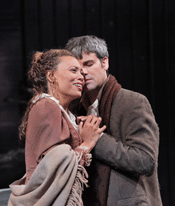 Alyson Cambridge as Mimi and Derek Taylor as Rodolfo [Photo by Ken Howard courtesy of Opera Theatre of Saint Louis]
Alyson Cambridge as Mimi and Derek Taylor as Rodolfo [Photo by Ken Howard courtesy of Opera Theatre of Saint Louis]
Among the excellent ensemble cast, Alyson Cambridge was an extremely musical and insightful Mimi. Her radiant singing epitomized the transient beauty that Mimi herself represents; each note blossomed like the flowers opening in spring and it was absolutely charming to see a Mimi with a beautiful smile. When Mimi touches Rodolfo’s outstretched hand in the dark as they search for her key, Cambridge murmured a small “oh.” The simplicity and reality of the moment was perfect.
Derek Taylor, making his OTSL debut as Rodolfo, presented a less sympathetic but more realistic Bohemian than audiences may be accustomed to. In Act I, his Rodolfo’s youthful callowness justified the character’s later insecurity and possessiveness. The other Bohemians of the garret were each as strong individually as they were as an ensemble. Eugene Chan portrayed Schaunard as the baby of the group and a budding ladies’ man. Timothy Mix was strong as a Marcello with van Gogh’s coloring but, thankfully, not his temperament. Above all, Steven Humes as Colline stood out for the refinement in both his singing and acting. (Having also enjoyed Humes’ cameo as the Voice of the Pasha in The Ghosts of Versailles, I am currently of the opinion that even the most wonderful operas can be made even better by Humes’ presence onstage.)
Amanda Majeski’s Musetta sparkled in Act II, although the show-stopping quality associated with the character was lessened by the liveliness of Cambridge’s Mimi. In fact, Majeski and Cambridge represented the two young women as girls in very similar situations. Of all the cast, Majeski’s character arc (from her kittenish fit in Act II to her quiet spirituality in Act IV) most exemplified Ocel’s sentiment in his director’s notes — Bohemia isn’t a profession or a lifestyle. Rather, it is a period in a person’s life when the pipe dreams always outnumber the pennies until hunger or pain forces them to move on.
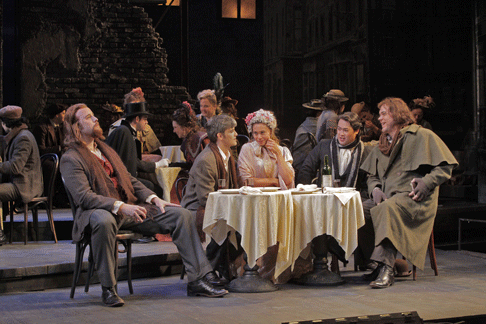 L to R: Timothy Mix as Marcello, Derek Taylor as Rodolfo, Alyson Cambridge as Mimi, Eugene Chan as Schaunard, and Steven Humes as Colline [Photo by Ken Howard courtesy of Opera Theatre of Saint Louis]
L to R: Timothy Mix as Marcello, Derek Taylor as Rodolfo, Alyson Cambridge as Mimi, Eugene Chan as Schaunard, and Steven Humes as Colline [Photo by Ken Howard courtesy of Opera Theatre of Saint Louis]
Judging by the fun he was having in the pit, conductor Ari Pelto could’ve been cast as a fifth Bohemian. There was a slight misstep when the marcia at the end of Act II dissolved into semi-chaos for a moment. Overall, though, the payoff in the orchestra and onstage was a Bohème to remember equally for its spirited and tender moments. The changes in the production, including the elimination of a large moon in Act I, improved upon the 2001 iteration by making everything less theatrical and more realistic. Robert Denton’s lighting design occasionally clashed with the rest of the naturalistic production. During Act III, despite it being a wintry dawn, strong silhouettes were thrown across the Parisian backdrop.
The Act I moon in Bohème might’ve disappeared, but it returned as part of Paul Pallazo’s stunning lighting design for Salome (seen on June 24). Along with set and costume designer Bruno Schwengl, Pallazo created an ingenious design in which the mesmeric moon was reflected onto the floor center stage and the eye was lead to the back wall. There, a circular opening acted as the entrance to the cistern which, when moved for the entrance of Jokanaan, had an effect like that of an oculus.
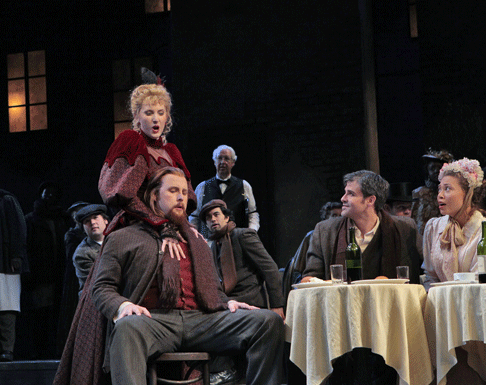 L to R: Amanda Majeski as Musetta, Timothy Mix as Marcello, Derek Taylor as Rodolfo, and Alyson Cambridge as Mimi [Photo by Ken Howard courtesy of Opera Theatre of Saint Louis]
L to R: Amanda Majeski as Musetta, Timothy Mix as Marcello, Derek Taylor as Rodolfo, and Alyson Cambridge as Mimi [Photo by Ken Howard courtesy of Opera Theatre of Saint Louis]
Choreographer and director Seán Curran (assisted to some degree by dramaturg and “consulting director” James Robinson) used this semi-sterile environment as the playing space for Strauss’ fin-de-siècle psychodrama. As one would expect, the production included a ‘Dance of the Seven Veils’ par excellence. The dance was both realistically impromptu and well thought-out. Furthermore, the dance fit seamlessly into the modern-dress context of the production while also referencing the Biblical origins of the story. Each of the veils was used to unique and surprising effect, including one made of Latex. Palazzo’s lighting design became an intrinsic part of the choreography by multiplying shadows one moment and creating a seductive glow the next. The highest compliment I can pay is not to describe this ‘Dance of the Seven Veils’ in detail because its effect was transfixing and, ultimately, indescribable.
Of course, the success of the dance was largely due to Kelly Kaduce in the title role. She’s well known in St. Louis as a singing actress, but Kaduce’s Salome pushed the singer well into the realm of a triple threat. In a part that famously requires the singer to look 13 and sound 30, Kaduce fits the bill and would be an entirely believable Salome even in high-definition. Not only are her looks and singing thrilling, Kaduce’s acting reflects the psychology of Strauss’ score in captivating detail. In the moments after Jokanaan is put back into the cistern and before the party of Herod and Herodias enters, Kaduce sits downstage and transforms from a petulant teenager to a dangerous woman using only her face.
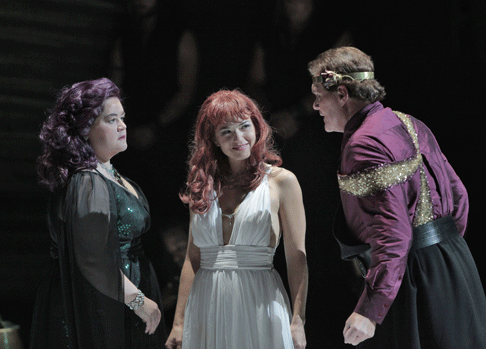 L to R: Maria Zifchak as Herodias, Kelly Kaduce as Salome, and Michael Hayes as Herod [Photo by Ken Howard courtesy of Opera Theatre of Saint Louis]
L to R: Maria Zifchak as Herodias, Kelly Kaduce as Salome, and Michael Hayes as Herod [Photo by Ken Howard courtesy of Opera Theatre of Saint Louis]
Stephen Lord conducted Kaduce and the rest of the cast with his usual panache and verve. The supporting cast acted and sang with style. As Narraboth, Eric Margiore brought level-10 intensity to his role from the moment the lights went up. Maria Zifchak was vocally compelling but she portrayed Herodias more as Herod’s wife than as Salome’s mother. In order to create real tension, it needs to be obvious that Herodias is the ultimate cougar and not a nagging housewife. Then, the instant Herod rips jewels off the mother’s neck and passes them to her own daughter, the Oedipal rivalry between the generations of women becomes shockingly apparent. Zifchak could’ve sung the part with more of the sex appeal obviously at her disposal. Tenor Michael Hayes was perhaps too desperate too soon as Herod. Remember, Herod is a bigwig, a mover and a shaker, as well as a pretty cagey guy. The audience needs to see him in control at first in order to fully register the change when his horror and paranoia “unman” him. Gregory Dahl looked perfect as Jokanaan and sounded nearly as good. Among the featured Gerdine Young Artists, Zach Borichevsky (as the Third Jew) sang particularly well.
Overall, this Salome was a gripping production included in a particularly strong season at OTSL. During this year of transition, OTSL may not have given its audiences the moon, but it definitely brought out some stars.
Alison Moritz
image=http://www.operatoday.com/SalomeKaduceOTSL.gif image_description=Kelly Kaduce as Salome shown with the head of Jokanaan [Photo by Ken Howard courtesy of Opera Theatre of Saint Louis]
product=yes
producttitle=Giacomo Puccini: La bohème
Richard Strauss: Salome
productby=Click here for cast of La bohème and other information
Click here for cast of Salome and other information
product_id=Above: Kelly Kaduce as Salome shown with the head of Jokanaan [Photo by Ken Howard courtesy of Opera Theatre of Saint Louis]
July 2, 2009
Carmen Triumphs (Again) at the Opéra Comique
At the Opéra Comique in Paris, the theater where it was first performed, Bizet’s Carmen has triumphed again. One of the most performed operas around the world, it has recorded nearly 3000 performances alone at the Comique. But a new production with a fresh perspective has given the old girl new life. Hugh Canning, of the Times of London, declares “Carmen has never sounded more revolutionary, romantic or thrillingly vibrant.”
Conductor John Eliot Gardiner brings along his polished Orchestre Révolutionnaire et Romantique to play on instruments which recreate the lost sound of the 19th Century orchestra. His Monteverdi Choir, with a discipline and artistic commitment not found in Parisian opera choruses, also showed a real sense of the theater. Stage director Adrian Noble, a former head of the Royal Shakespeare Theater, created an intense, elegant, cliché-free staging that tells the story with an engaging freshness. There has seldom been a director so committed to the details of this fatal confrontation and who could work with such talented singing actors. The single set easily becomes taverns and bullrings thanks to the lighting of Jean Kalman, who is, quite simply, the best in the business.
The fact that this opera is being performed in a theater with only 1255 seats certainly contributed to the more intimate reading. Most American audiences, for example, see this opera in theaters two or three times the size of the Comique. Carmen, usually a season filler, is a vehicle for stars to strut and orchestras, twice the size that would fit in the Comique pit, to swell and soar. Gardiner, however, conducts with a clarity and sure impulse that strips away the accumulated years of bombast. Among other details, the First Act duet between Don José and Micaêla finished with a quiet intensity and not with the shouting match one usually hears. He also restored several sections which are routinely cut, including a profoundly disturbing, almost Wagnerian bit of music when Carmen learns that the cards predict death.
The grand Italian soprano Anna Caterina Antonacci was in top form for this role. She has already recorded it at the Royal Opera in London on DVD but this effort is a different, more subtle reading, more in tune with Gardiner’s adherence to the storytelling art of Adrian Noble. As Don José, the talented American tenor Andrew Richards, fully recovered from an indisposition which caused him to miss an earlier performance, was able to give 100% for the performance on June 25, broadcast live to fifty theaters in France and Switzerland. That night was also recorded for later television broadcast and thus become a candidate for a DVD release. The gifted soprano Anne-Catherine Gillet, who sang the role of Micaêla, was quite fine, as was the Escamillo of Nicolas Cavallier. All of the second roles were played to perfection with a particularly lively children’s chorus, Maîtrise des Hauts-de-Seine, who actually, for the first time in my experience, sang intelligible French.
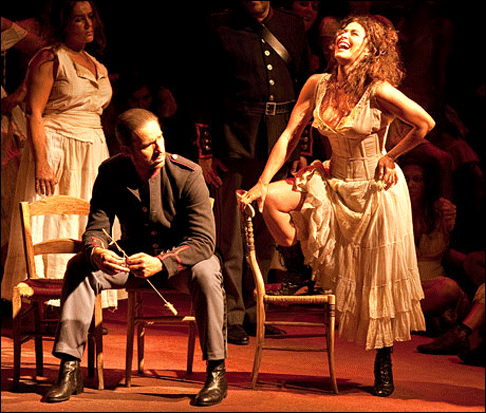
This latest acclaimed production, sold-out months ago, only adds to the stature of the house. Both English conductor John Eliot Gardiner and Italian mezzo Anna Caterina Antonacci have homes in Paris. It would not be difficult to imagine working with either of these two grand artists to present something compelling. Gardiner’s reading of Berlioz’ Les Troyens at the Theatre du Chatelet in 2002, available on DVD, revealed new color and detail plus Antonacci sang a Cassandre for the ages.
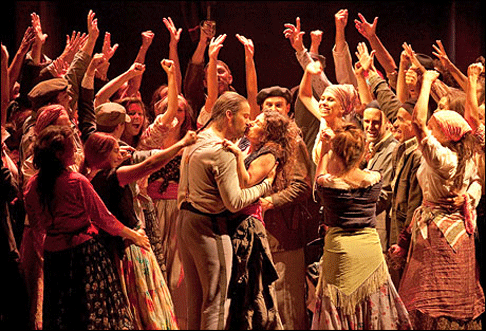
The Opéra Comique is one of Europe’s most elegant venues and a lively complimentary program, Les Rumeurs, is assembled around each new opera; in addition to concerts of Bizet’s music, the 1915 silent film with the same name and subject by the young Cecil B. DeMille was only another part of the festivities. The season opener this year, Purcell’s Dido and Aeneas, with conductor William Christie working with stage designer Deborah Warner, was thought by many to be the finest production in Paris this season. The theater’s recent efforts to reexamine the French repertory, scandalously neglected by the French since World War II, is clear in the next season announced recently. Operas by Messager, Grétry, Thomas, Berlioz (Béatrice et Bénédict) and Aperghis grace a schedule ending with Debussy’s Pelléas et Mélisande, again with Maestro Gardiner and his musical forces.
The new season can be previewed (in French) at www.opera-comique.com.
This review first appeared in Playbill on 1 July 2009. It is reprinted with permission of the author.
image=http://www.operatoday.com/CarmenComique01.gif imagedescription=A scene from Carmen at the Opéra Comique [Photo by Pierre Grosbois]
product=yes producttitle=Georges Bizet: Carmen productby=Carmen: Anna Caterina Antonacci; Don José: Andrew Richards; Micaëla: Anne-Catherine Gillet; Escamillo: Nicolas Cavallier; Le Dancaïre: Françis Dudziak; Le Remendado: Vincent Ordonneau; Zuniga: Matthew Brook; Moralès: Riccardo Novaro; Frasquita, Virginie Pochon; Mercédès: Annie Gill / Louise Innes; Lillas Pastia: Simon Davies; Un guide: Lawrence Wallington. The Monteverdi Choir. Maîtrise des Hauts-de-Seine. Orchestre Révolutionnaire et Romantique. Direction musicale: Sir John Eliot Gardiner. Mise en scène: Adrian Noble. Décors et costumes: Mark Thompson. product_id=Above: A scene for Carmen [All photos by Pierre Grosbois]